978 views
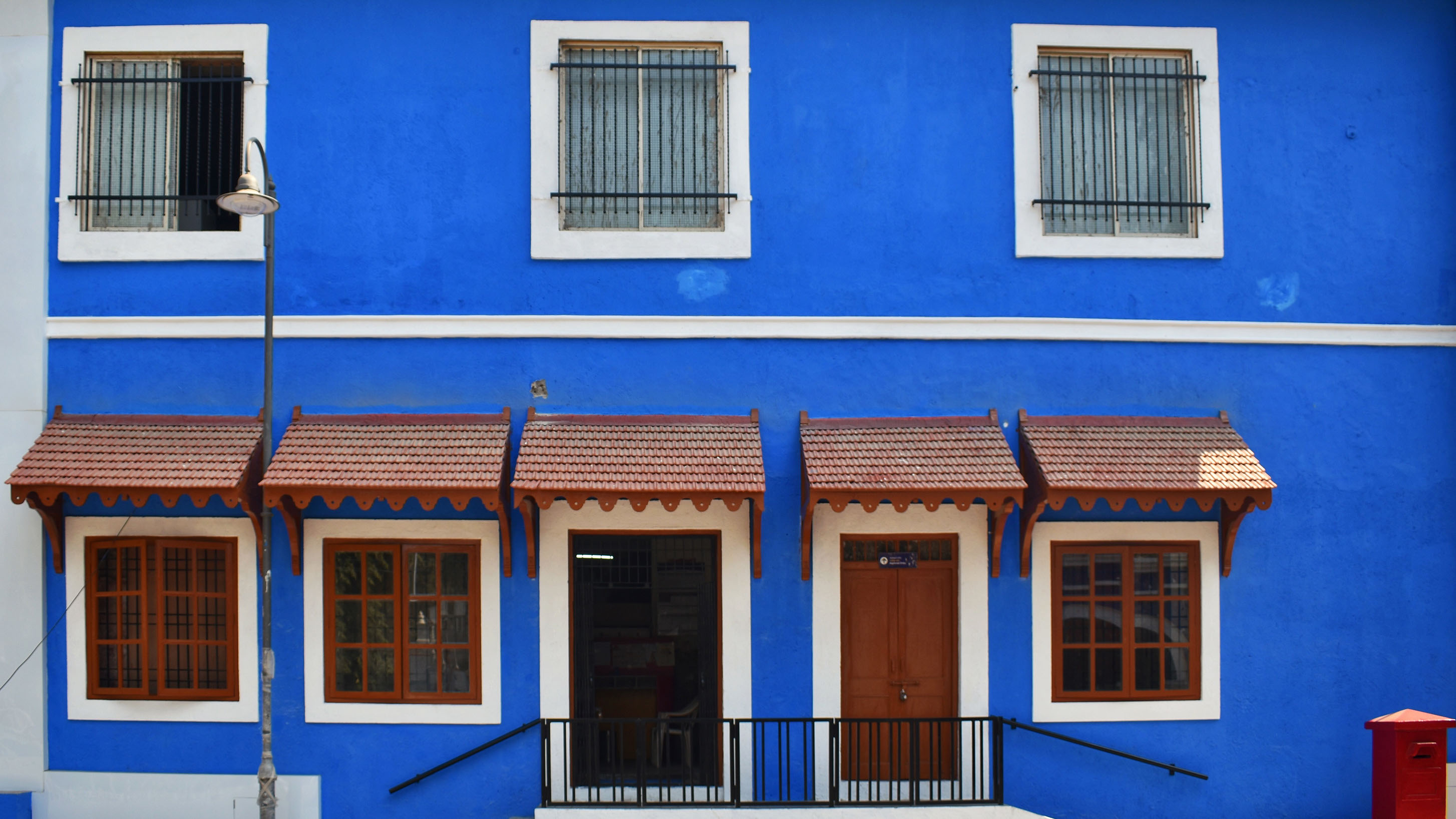
Tracing Portuguese Footprints in Daman
By Rahuldev Rajguru
Last Updated: 24 Jun 2023
In a captivating beachside town, nestled on the border of the arid state of Gujarat, a tale of allure and hidden treasures unfolds. For decades, it has basked in the limelight, though not for the right reasons. Although Gujaratis are known for their wanderlust, they throng a thousand kilometers away to the sun-kissed beaches of Goa, overlooking a similarly captivating gem in their own backyard.
Enter Daman, a former Portuguese colony now proudly standing as a union territory of India. Though geographically separated from Gujarat, it pulsates with the vibrant heartbeat of Gujarati culture and tradition. However, one remarkable distinction sets it apart: the freedom to legally acquire and revel in the pleasures of alcohol - a luxury prohibited throughout the entire state. It is a peculiar facet of human psychology that we are irresistibly drawn to that which is forbidden, shackled by societal constraints. Daman, a veritable oasis of indulgence, becomes a magnetic haven for Gujaratis, particularly during holidays and the exhilarating embrace of the New Year.
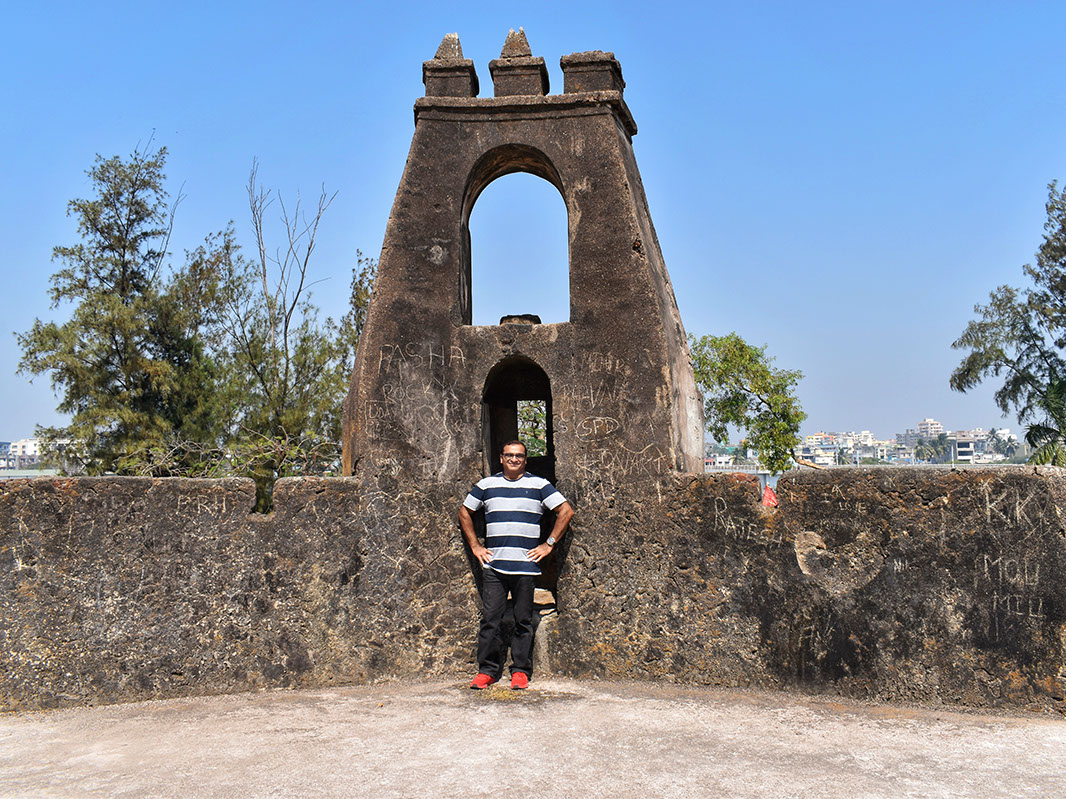
In front of the bastion of Moti Daman Fort
This aquatic paradise has garnered a fervent following among the denizens of nearby cities, with Surat emerging as a significant contributor to the flourishing restaurant scene in Daman. The vitality of these establishments owes its prosperity to the ardor of the alcohol-loving people of Gujarat, who flock here seeking the ultimate liberation for their taste buds and spirits.
The first time I visited Daman was 20 years ago. The sheer vibrancy of its atmosphere left me utterly spellbound. However, the teeming masses of alcohol enthusiasts, a realm so unfamiliar to my own inclinations, caught me off guard. With its laid-back beach culture and charming seaside hotels, Daman possessed an undeniable allure. Yet, there was a shadow hanging over it, tarnishing its reputation for all the wrong reasons. This caused me to perpetually omit it from my future travel plans.
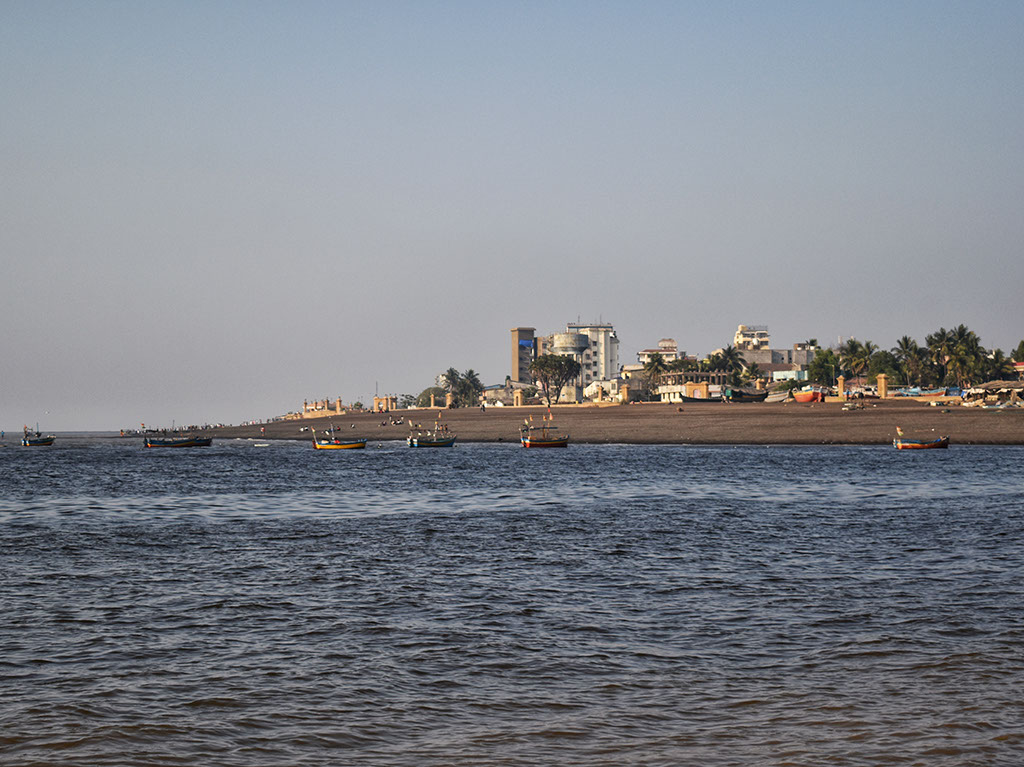
Nani Daman's shoreline, Devka Beach
However, fast forward to the present, and a reunion with my college buddies presented an opportunity to revisit this destination. As they were stationed in Atul, one of the world's greenest chemical complexes, I proposed Daman as our rendezvous point, just an hour's drive away. Rumors of Daman's evolving landscape had piqued my curiosity, and I yearned to witness it firsthand. Since we were all teetotallers, our goal was to relish quality time together and delve into the historical wonders of this enchanting city.
To say that Daman didn't disappoint would be an injustice; rather, I was flabbergasted by its remarkable transformation.
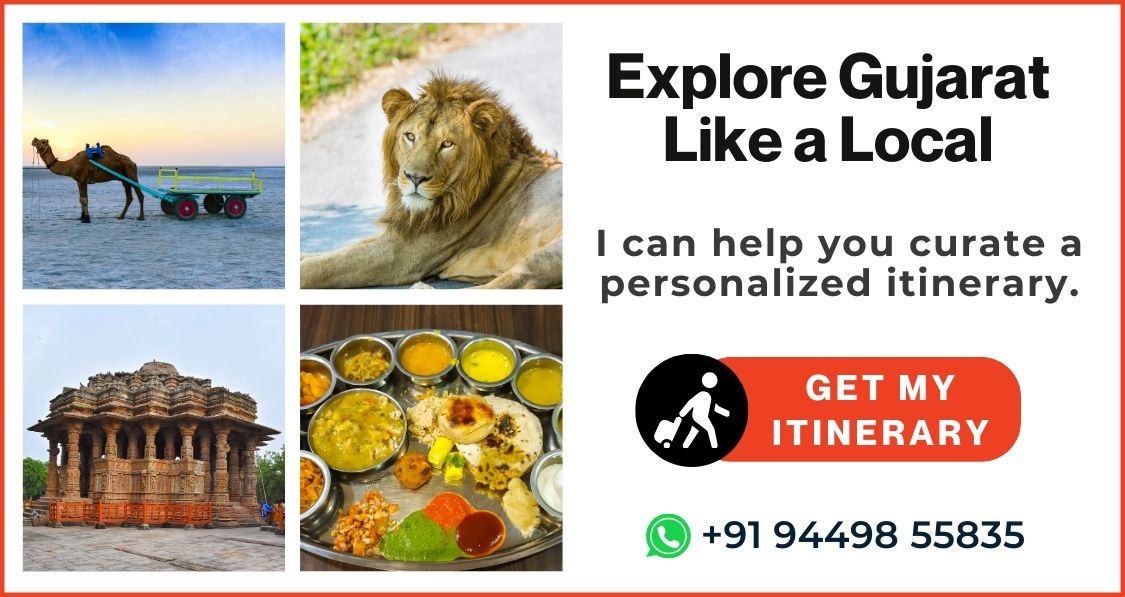
A History of Daman: Conquest, Colonialism, and Portuguese Influence
The history of Daman is steeped in tales of conquest and colonialism. Originally, Daman and Diu (coastal cities separated by Gulf of Cambay) were part of the Sultanate of Gujarat during the 15th and 16th centuries. However, their destiny took a dramatic turn when Humayun, the Mughal emperor, invaded Gujarat under Sultan Bahadur Shah in the early 16th century.
An intriguing twist of fate occurred in 1523 when the Portuguese Captain, Major Diogo de Melo's vessel was caught in a violent storm, pushing it towards the shores of Daman. This incident not only marked their arrival but also laid the foundation for the establishment of Portuguese colonies in India.
In an effort to maintain amicable relations with the formidable Portuguese forces, who had already established a strong presence by now, Bahadur Shah chose a conciliatory approach. In 1534, he signed the Treaty of Bassein with the Portuguese, relinquishing Diu to them. Subsequently, in 1559, Daman, along with its bustling seaport strategically positioned for international trade, also fell under Portuguese control.
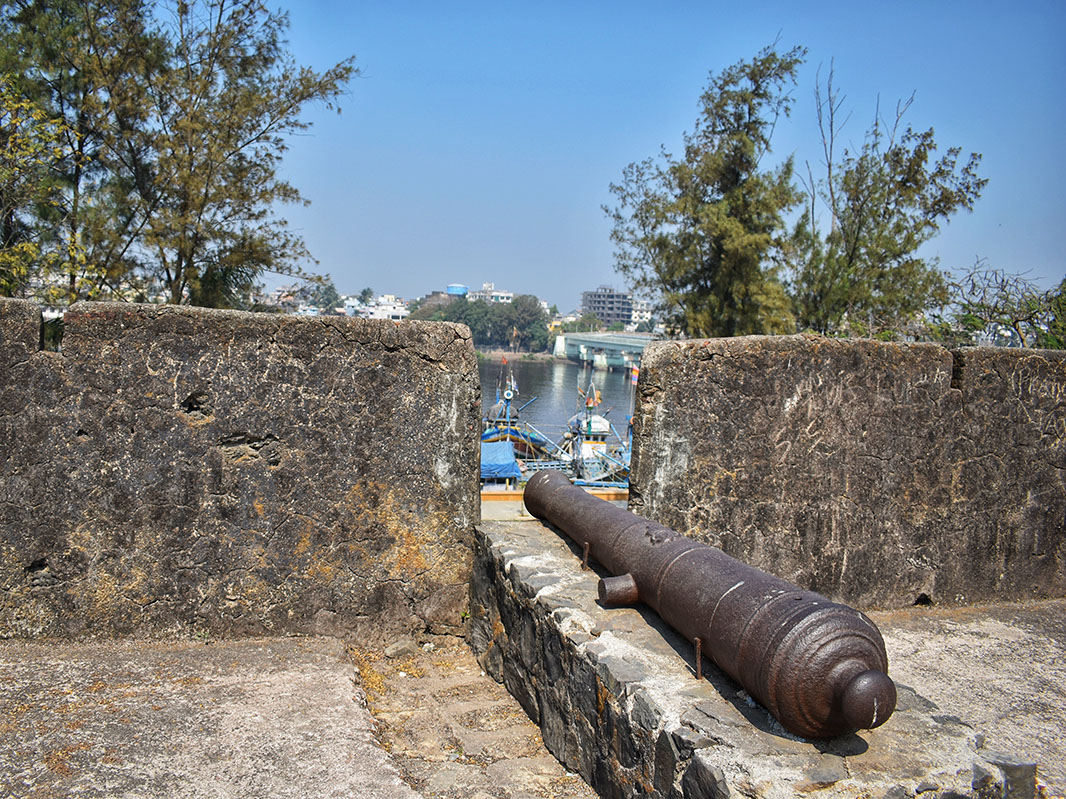
Remains of the Portuguese occupation in Daman
The Portuguese, recognizing the significance of Daman as a potential stronghold, constructed a larger fort in Moti Daman during the 16th century to safeguard against Mughal incursions. For over four centuries, both Daman and Diu remained integral parts of the Portuguese dominions in India and were governed from Goa, their colonial capital.
India became independent from Britain in 1947, and Lisbon refused to give up its territories in India. However, winds of change were stirring on the horizon. On December 17, 1961, the Indian armed forces launched "Operation Vijay" to reclaim Daman, Diu, Dadra & Nagar Haveli and Goa from Portuguese control. As a result of this historic event, these regions were reunited with the rest of India. Daman today stands as a testament to its storied past, blending Portuguese influences and indigenous traditions. It invites visitors to explore its rich history and scenic beauty.
The Geographical Distribution of Daman
Daman, serving as the capital of the union territory of Dadra & Nagar Haveli, Diu, and Daman, is an intriguing city characterized by its unique geographical distribution. Surprisingly, these three cities are spread out and share borders with the state of Gujarat in diverse locations. This arrangement bears resemblance to Puducherry, another union territory, comprising Pondicherry, Karaikal, Mahe, and Yanam, all situated in proximity to Tamil Nadu and Andhra Pradesh.
The city of Daman is divided by the Daman Ganga River, giving rise to two distinct sections known as Nani Daman and Moti Daman. In Gujarati, "Nani" signifies small, while "Moti" translates to big. It is intriguing to note that despite the nomenclature, Nani Daman is actually larger than Moti Daman and was previously renowned as a hub for those with a penchant for alcoholic beverages. On the other hand, Moti Daman has been thoughtfully developed as a modern area, designed to appeal to tourists seeking tranquility and respite from the hustle and bustle of urban life. Given Daman's relatively modest size, commuting between these two parts is conveniently manageable.
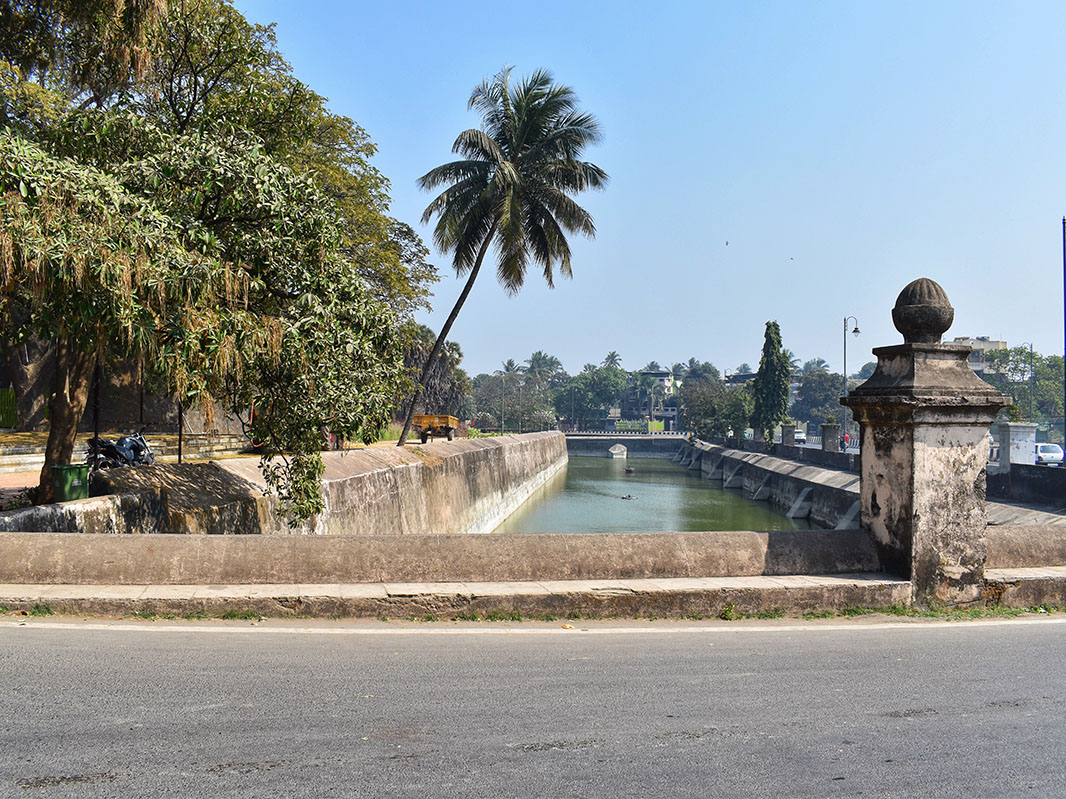
River Daman Ganga bisects Daman into two regions
During our visit, we opted to stay in Moti Daman. Unlike Nani Daman, this region does not have sea-facing hotels, but it boasts a number of modern boutique hotels and resorts that exude a modern charm amidst serene surroundings. Nest Beacon Resort, located just a 10-minute stroll away from Jampore beach, became our chosen abode, blending convenience and a tranquil environment.
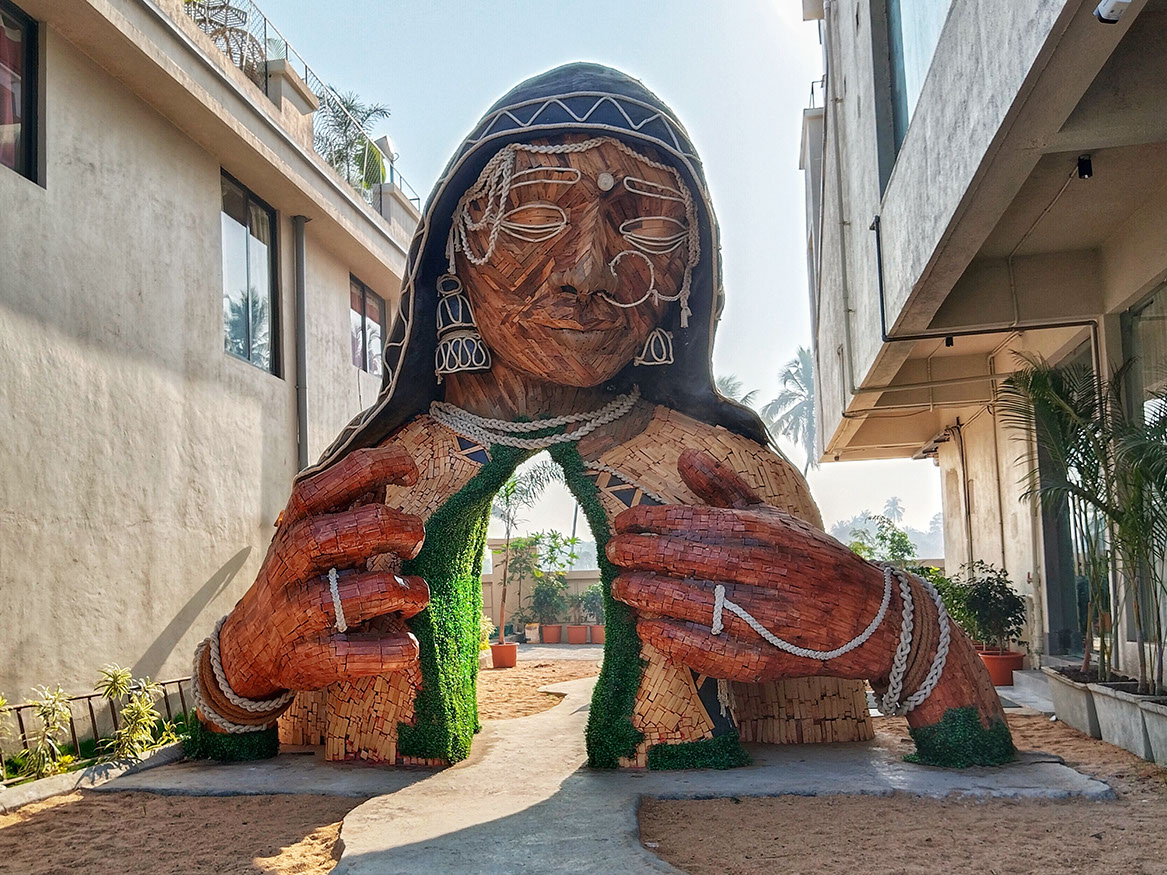
The beautiful wooden structure of a traditional Gujarati woman at our resort
Moti Daman Fort
Moti Daman Fort stands as a testament to the grandeur of its Portuguese heritage, leaving an indelible mark on the cityscape of Daman. Constructed in 1559, this magnificent fort weaves its own compelling tale, beckoning visitors to immerse themselves in its historic allure. Once in a state of ruin, the fort has undergone a remarkable resurrection, emerging as a popular tourist attraction in Daman.
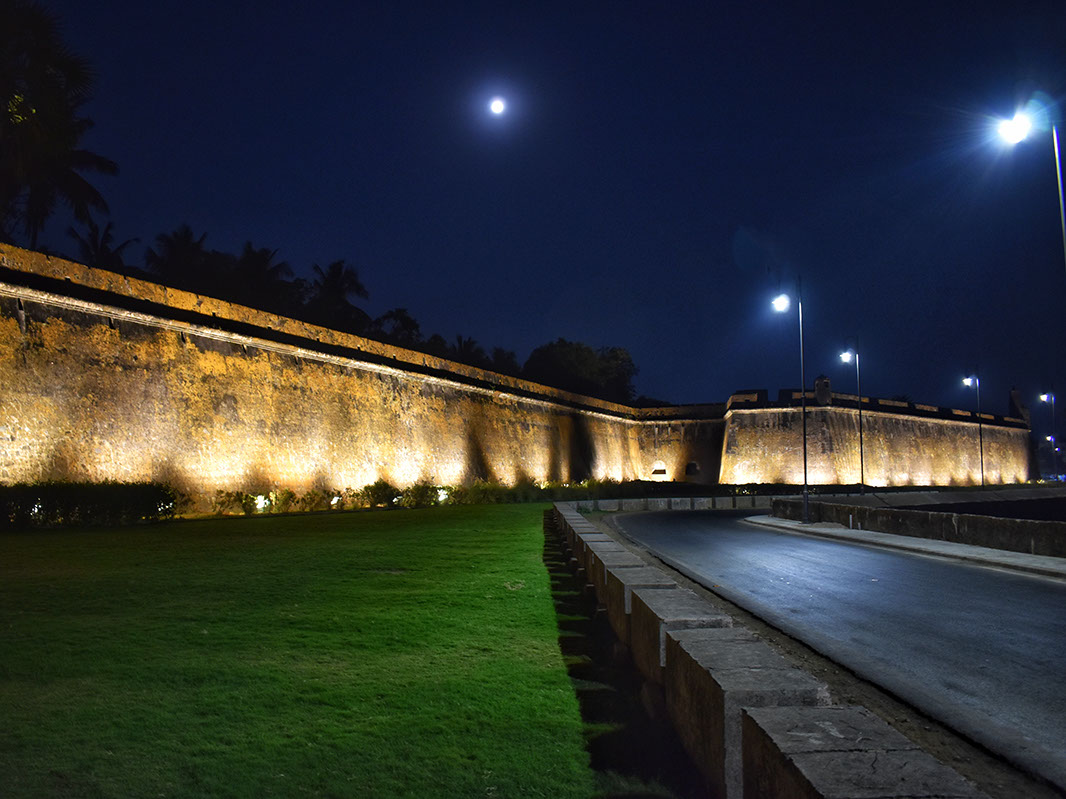
During the night, the lighting decorations on the exterior of the resurrected Moti Daman Fort enhance its grandeur
Comprising ten bastions and two awe-inspiring gateways, the Moti Daman Fort stands as a formidable stronghold. On its southern flank, a protective moat serves as a barrier, while the northern side is shielded by the flowing embrace of the river. As you embark on a leisurely 15-minute walk from the sea gate to the land gate, a remarkable transformation occurs, whisking you back in time to an era of resplendent grandeur and Portuguese architectural splendor.
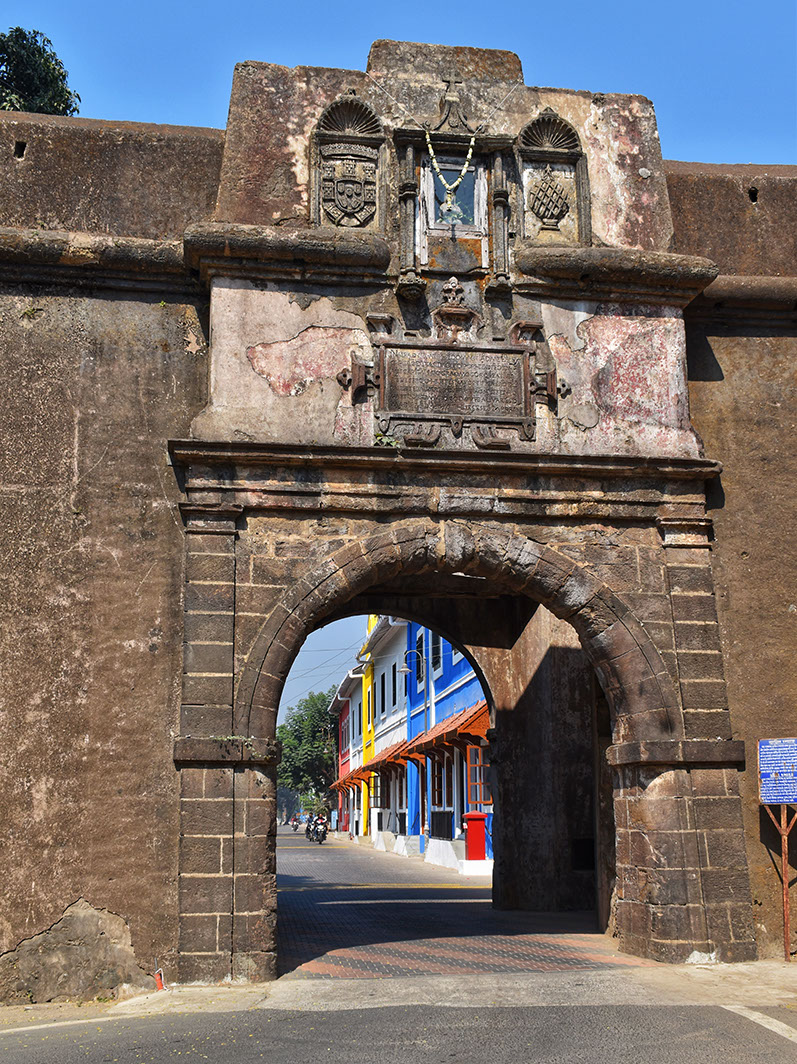
Sea Gate of the Moti Daman Fort with a Coat of Arms at its top
Walking through the fort's enchanting passages, one cannot help but marvel at the preservation of its original Portuguese buildings. These architectural gems, now transformed into government offices, have retained their authentic charm, with their thatched slate roofs and intricate details intact. What truly arrests the attention is the riot of Mediterranean pastel colors that grace these buildings. Vibrant hues such as ochre, blue, and pink paint a vivid tableau, infusing the fort with an air of vivacity and exuberance.
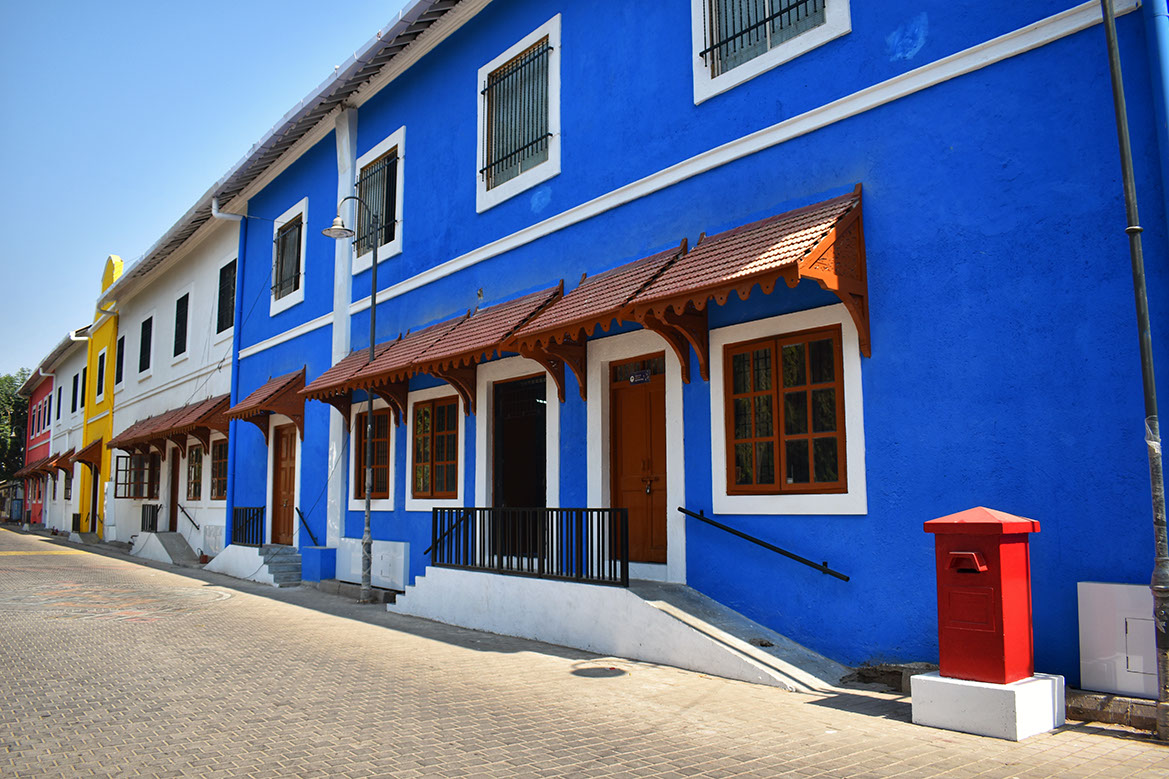
A riot of colors greets you as you enter the fort through the Sea Gate
Moti Daman Fort stands as a living testament to the rich legacy of Portuguese influence, an architectural masterpiece that exudes both power and beauty. It invites visitors to step into a bygone era, where time seems suspended and the grandeur of the past converges with the vibrant colors of the present.
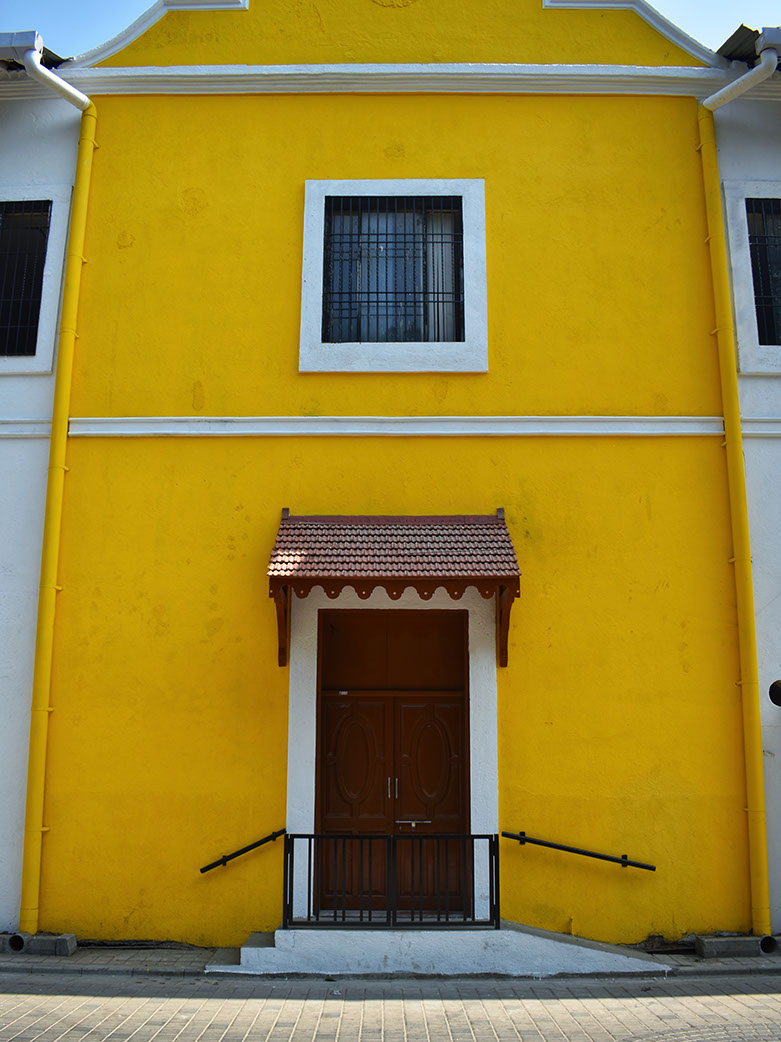
Colorful Portuguese-style house converted to a secretariat office
Within its enchanting walls, Moti Daman Fort offers a glimpse into the past and a wealth of hidden wonders waiting to be discovered. It is unfortunate, however, that the absence of knowledgeable guides or information kiosks leaves visitors longing for a deeper understanding of the fort's rich history and intricate details.
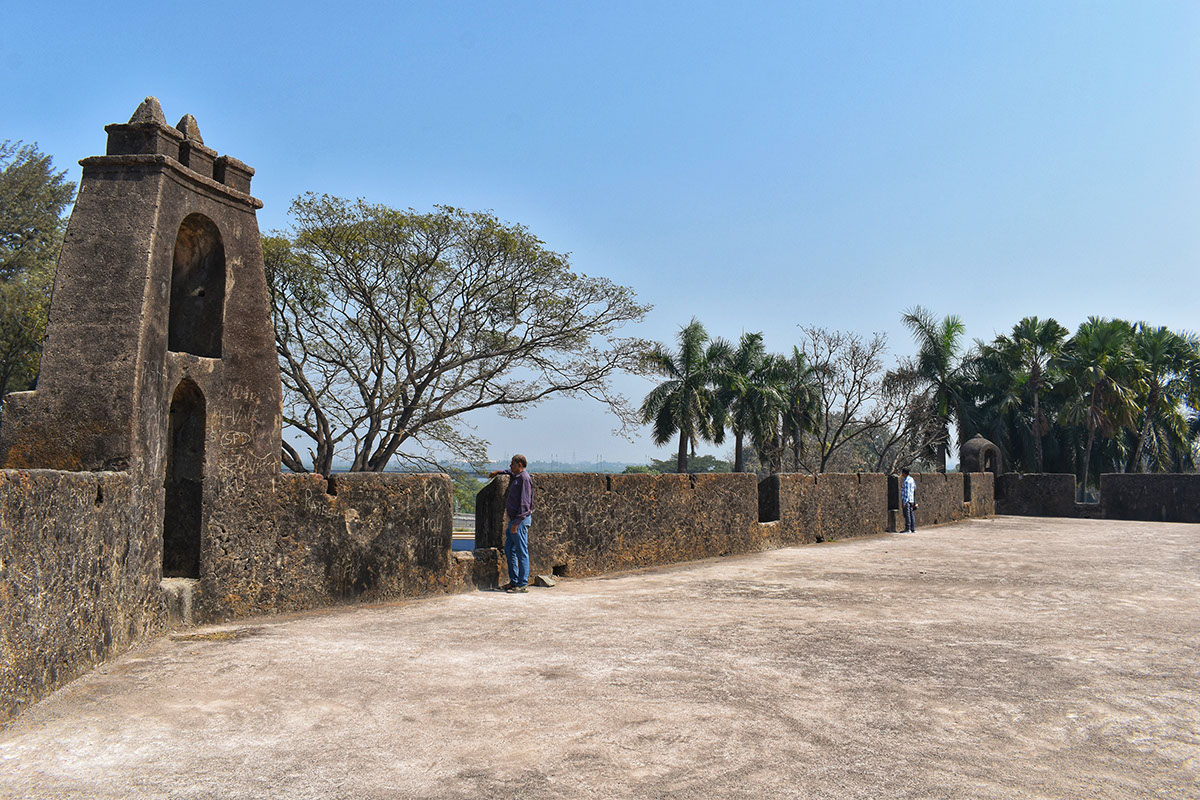
The upper floor of Moti Daman Fort has lookout points in the bastion facing the ocean
Bom Jesus Church
The Church of Bom Jesus in Daman stands as a testament to the rich Catholic heritage deeply intertwined with the city's Portuguese connection. Located within the main secretariat area of Moti Daman Fort, this historic church is a remarkable example of Portuguese engineering.
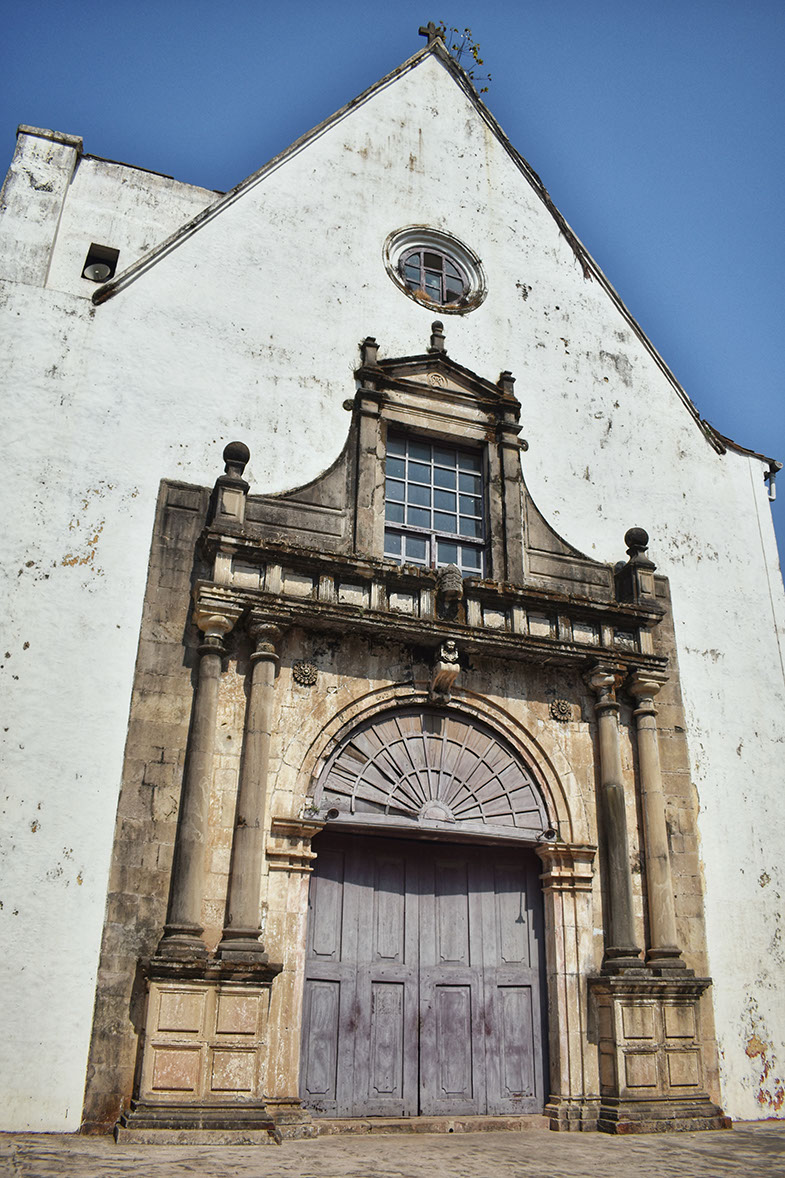
The wooden entrance to the Bom Jesus Cathedral
Established in 1559 and consecrated in 1603, Bom Jesus Church has a storied history that spans centuries. Originally dedicated to the Virgin Mary, it underwent a transformation in the early 17th century when it was rededicated to the infant Jesus and renamed Bom Jesus Church. During the early days of Portuguese settlement, it served as a parish church, nurturing the spiritual needs of the growing Catholic community.
The Church showcases a remarkable blend of Portuguese and Roman architectural styles, characterized by its decorative and intricate design. It stands as a testament to the mastery and quality of craftsmanship displayed during the colonial era, specifically reflecting the popular Baroque architecture style.
As one approaches the Church of Bom Jesus, the exterior immediately catches the eye with its ornate carvings and sculptures. The prominent statue of the infant Jesus takes center stage, surrounded by statues of six saints, while an impressive architectural facade enhances the grandeur of the church.
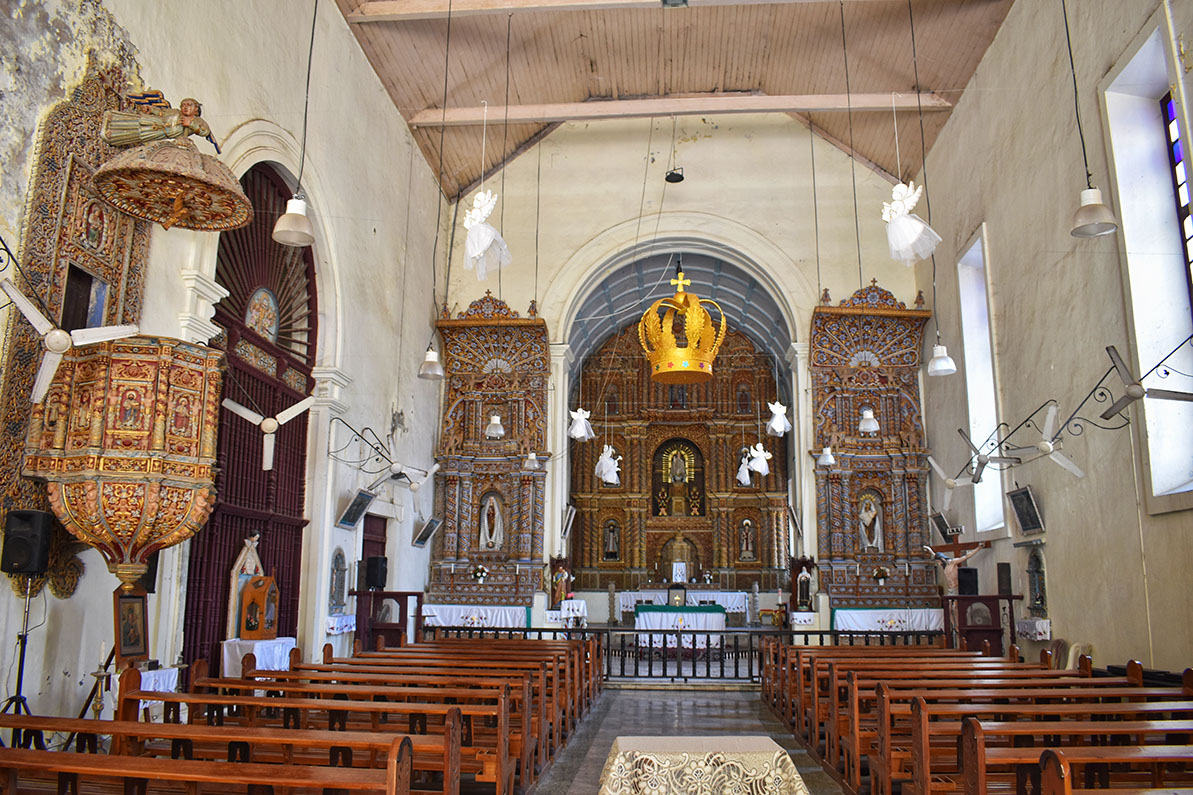
An interior view of Bom Jesus Church
Upon entering the church, visitors are greeted by a stunning interior adorned with exquisite details. Beautifully crafted and gilded, the grand altar is the focal point of the cathedral. A statue of the infant Jesus, considered the most significant relic of the church, graces the altar, radiating a sense of reverence and devotion. Its aesthetic beauty is further enhanced by scrolls and floral patterns.
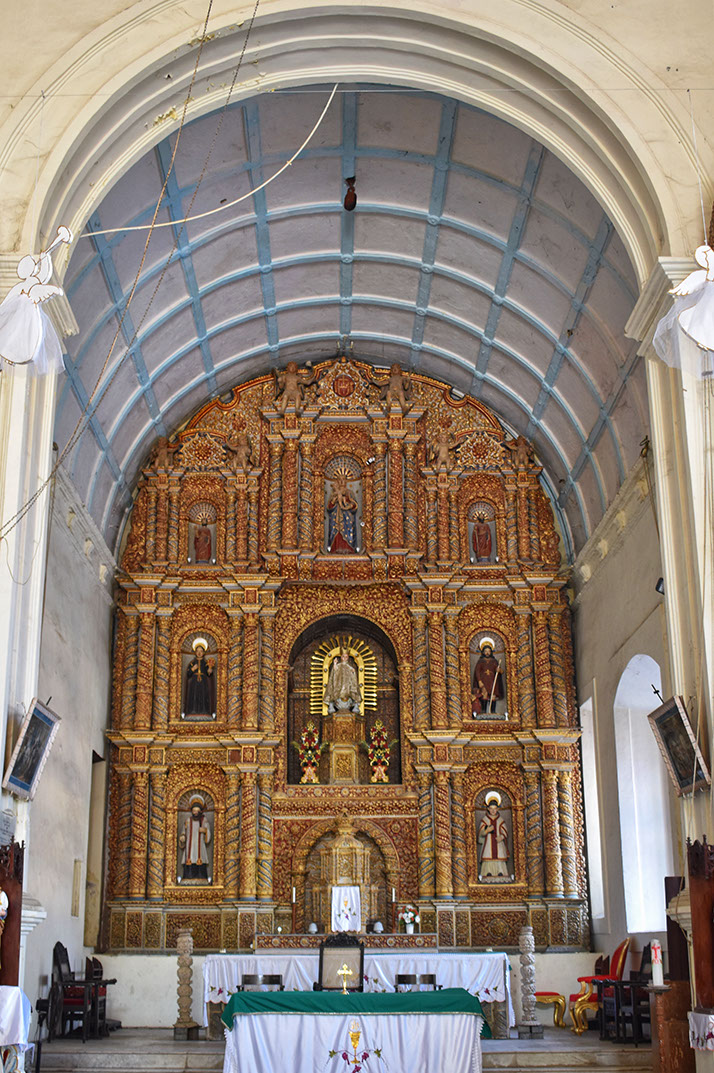
Original Portuguese wood carving art adorns this mesmerizing altar
The interiors also showcase superbly bejeweled lofty ceilings and intricately designed rococo details, demonstrating the meticulous attention to detail by the craftsmen. The wood paneling throughout the church is richly decorated with ornate carvings and patterns. A beautifully carved balcony adds an additional touch of elegance.
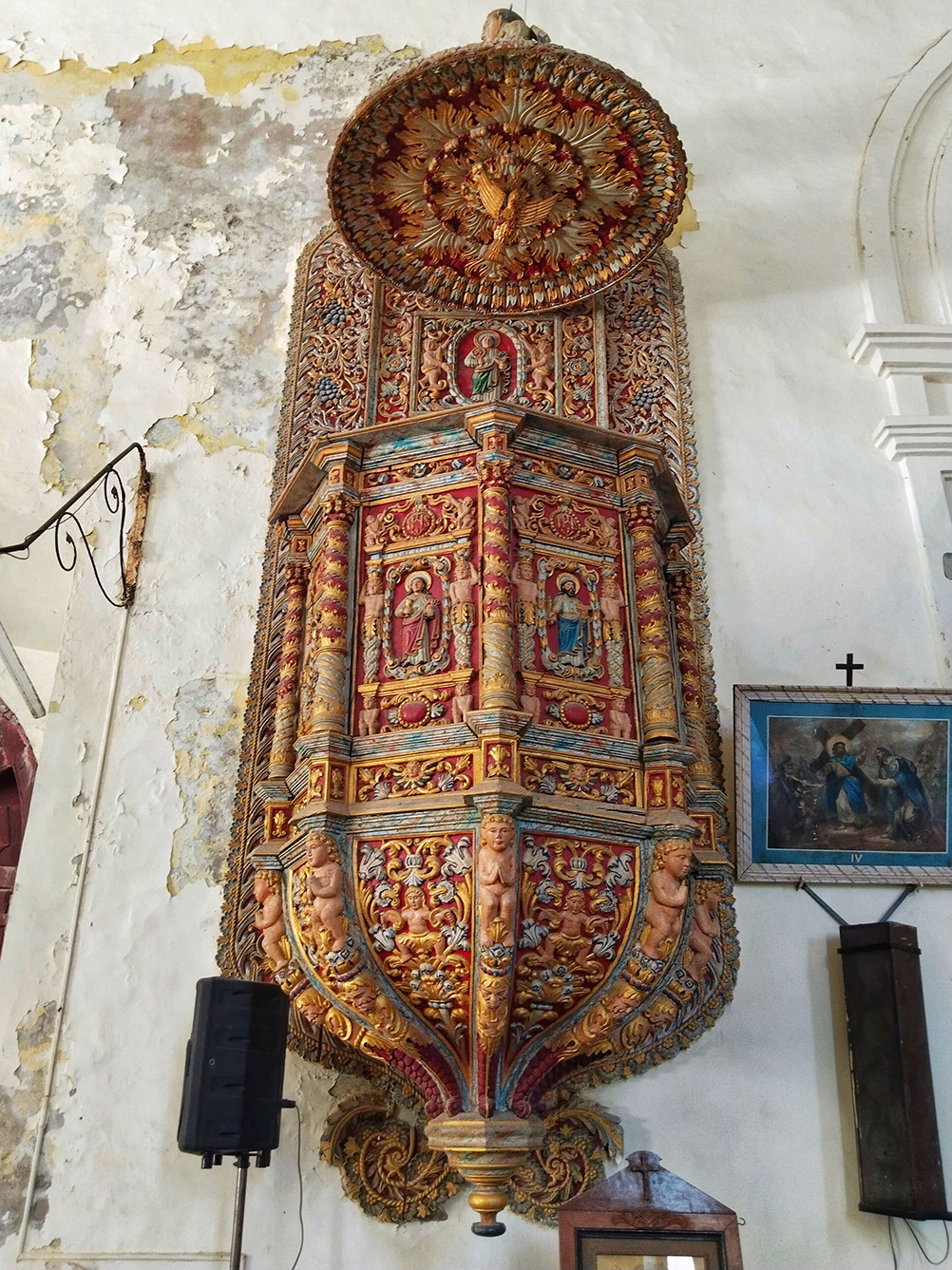
An intricately crafted Pulpit from where the preacher delivers a sermon
The church's architecture is complemented by its exquisite stained glass windows, which filter soft, colorful light into the sacred space. They depict religious scenes and symbols, adding to the spiritual atmosphere within the church.
The Chapel of Our Lady of Rosario
The Chapel of Our Lady of Rosario, situated just a short minute's walk from the Bom Jesus Church, may appear unassuming from the outside, but it holds a delightful surprise with its elaborate interior. The chapel's ceiling reminded me of La Saleth Church in Kodaikanal.
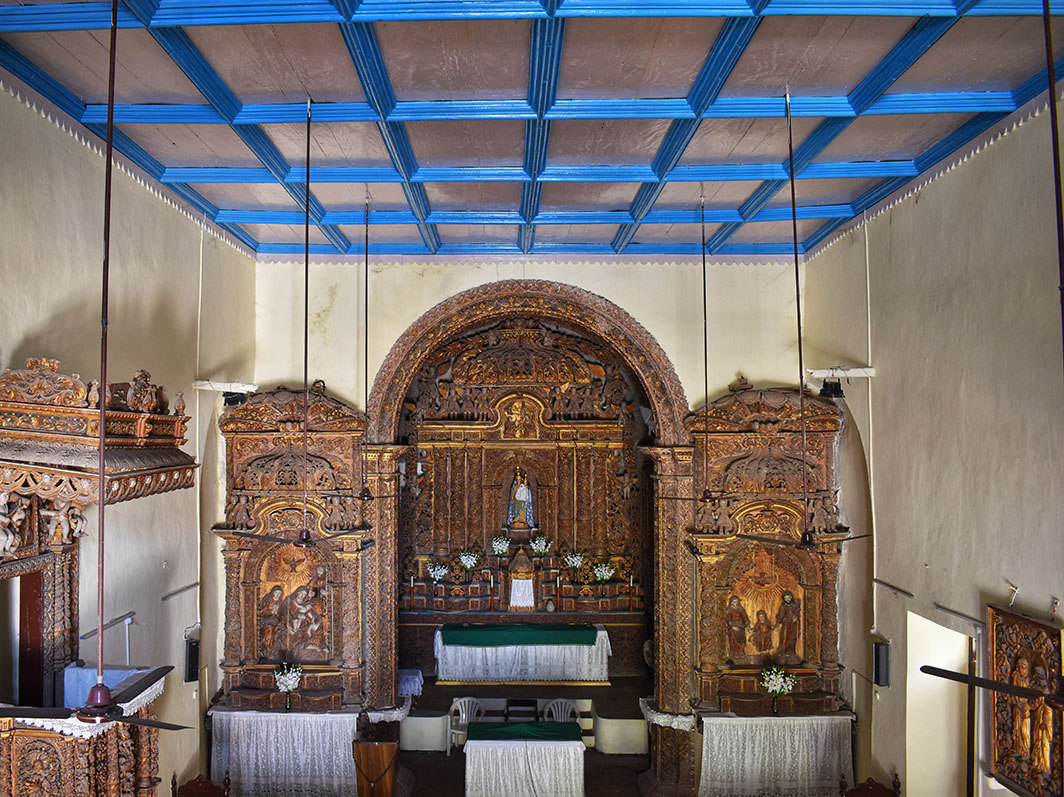
View from the upper floor of chapel
Upon entering the chapel, visitors are immediately greeted by a sense of awe as they behold the exquisite interior. The focal point of the chapel is the statue of Mary of Rosary, believed to have been brought from the Dominican monastery of Daman. This sacred statue adds a spiritual aura to the place.
One of the remarkable features of the Chapel of Our Lady of Rosario is its meticulously detailed wood carvings. The craftsmanship is evident in every design, showcasing the dedication and skill of the artisans who created them.
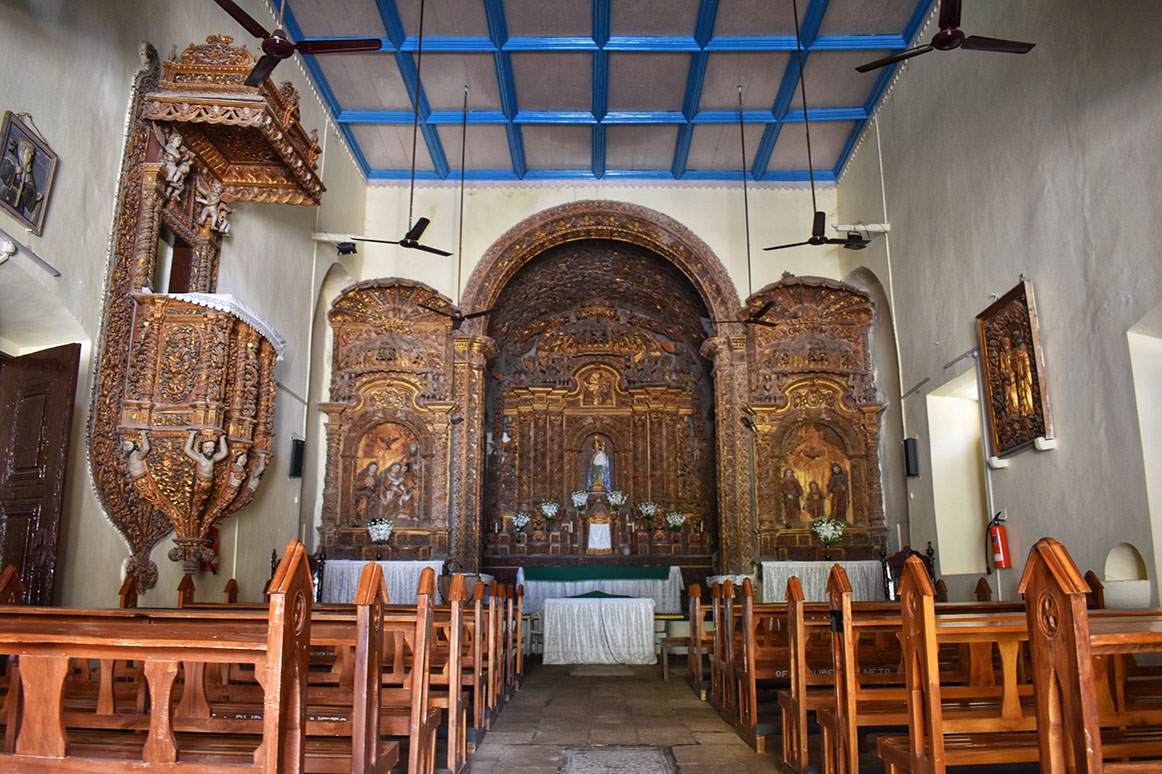
An overview of the church from the front door
The lateral wall of the apse displays a series of magnificently carved stories from the Bible depicting Christian saints. Among them, the story of the Last Supper stands out, capturing the profound significance of this pivotal moment in Christian history. The details in carvings bring these stories to life, allowing visitors to immerse themselves in the narratives of faith.
The ceiling of Altar is adorned with a stunning display of multi-colored rose petals and cherubic golden angels. This ornate decoration adds a touch of celestial beauty to the place. The interplay of colors and the delicate craftsmanship of the cherubic angels evoke a sense of serenity and spiritual upliftment. Legend has it that the Portuguese placed the statue of Mary of Rosary on the altar as an expression of thanksgiving for being saved from invasion by the Maratha forces led by Shivaji Maharaj.
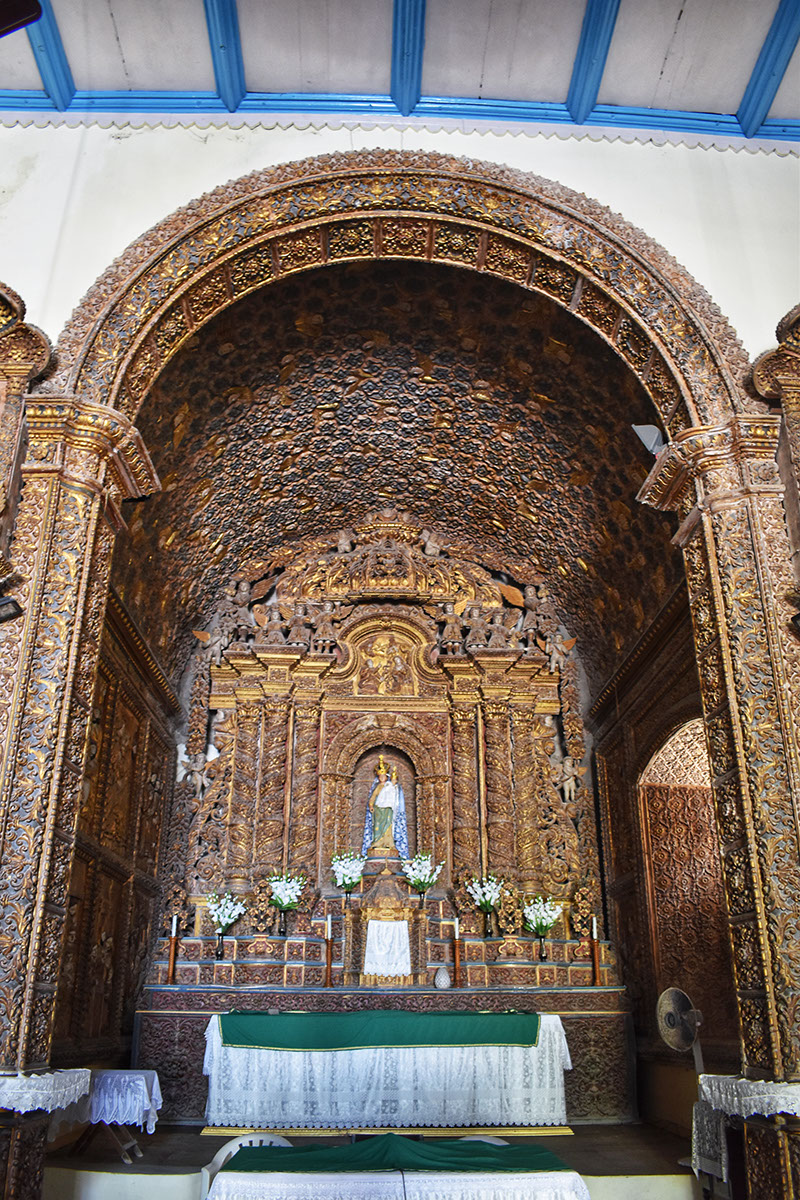
Mary Rosary statue inside the altar with rose petals carved into the ceiling
An ornately carved altar graces the front of the chapel. The carvings on the altar, originally painted in gold, tell a tale of opulence and devotion. Over time, the paint has faded and chipped off in certain places, revealing the passage of time and adding a touch of antiquity to the altar's appearance.
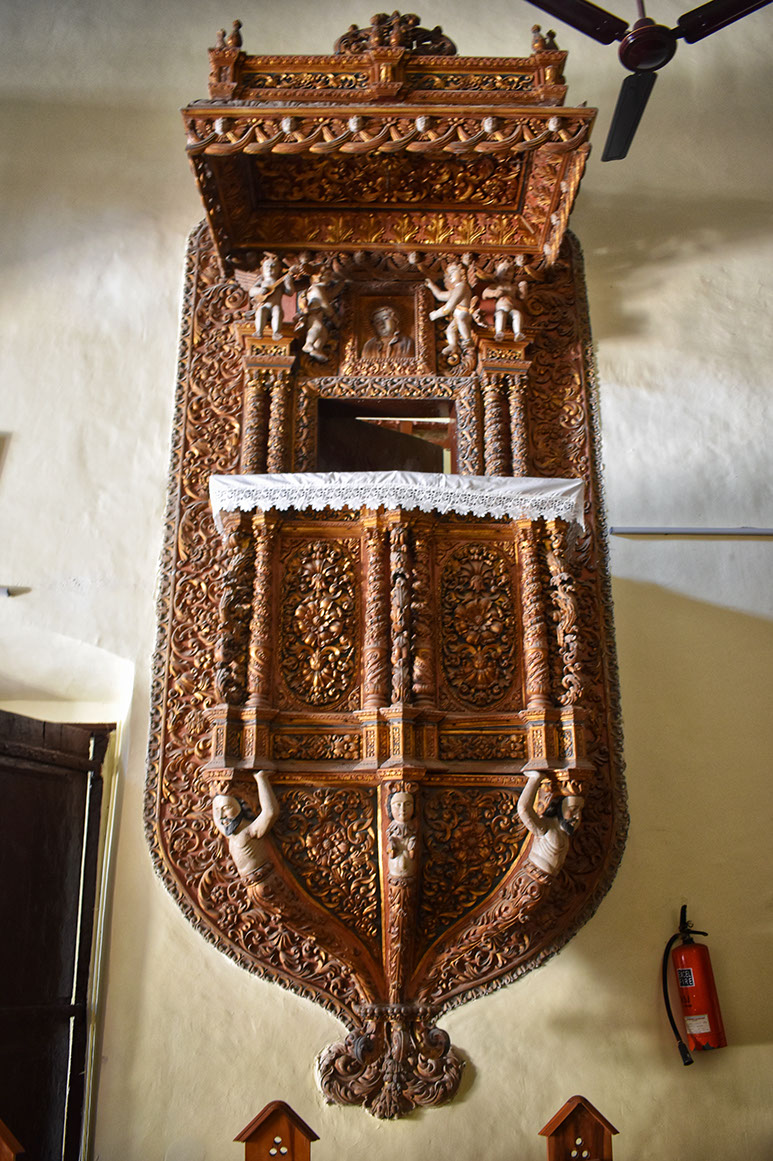
Wooden pulpit with intricate carvings
The Liberation Memorial
At the outer wall of Moti Daman Fort, near the Sea Gate, a solemn memorial stands as a reminder of the liberation of Daman by the Maratha Light Infantry in 1961. In addition to its symbolic significance, this memorial includes a military tank, representing the strength and valor of the Maratha soldiers who fought to free the city from Portuguese occupation. It serves as a tribute to their courage and sacrifice, commemorating the historic event that brought independence to Daman.
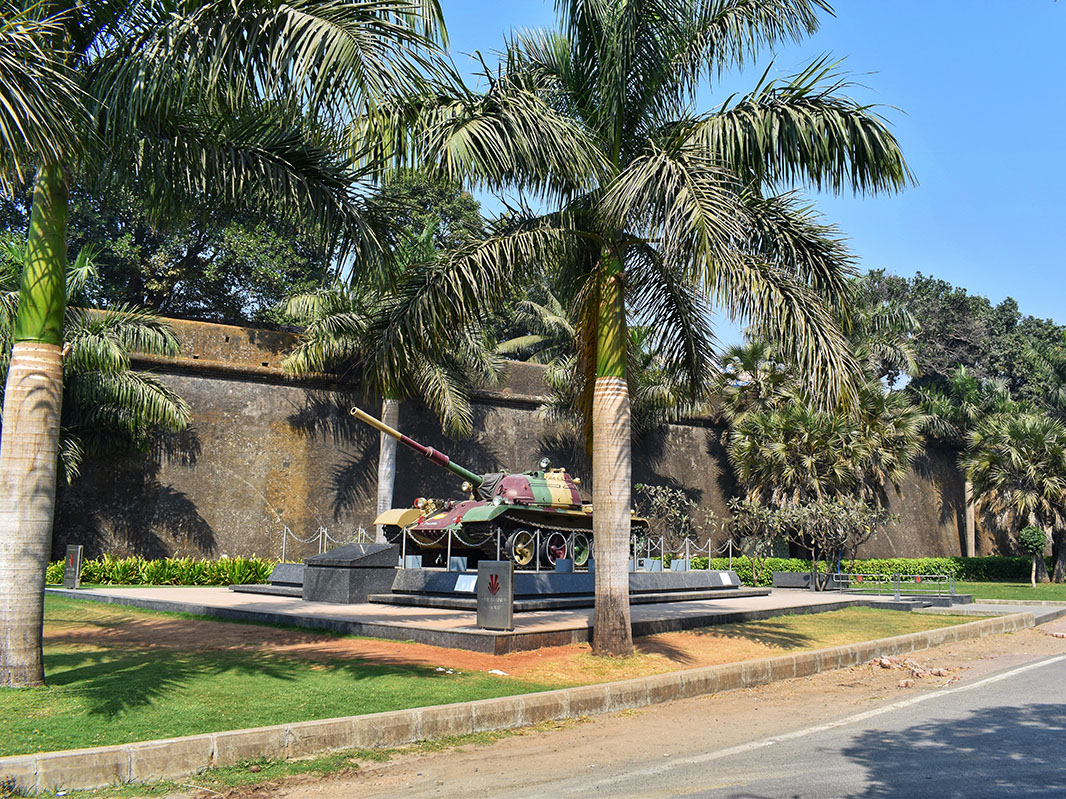
War memorial at Moti Daman Fort, a testament to Operation Vijay's triumph, symbolizes the liberation of Daman by the brave Indian Armed Forces
Daman's Culinary Landscape
Indulge your taste buds in a culinary adventure as you explore the vibrant food scene of Daman. If you truly want to savor the essence of this coastal paradise, then tasting the seafood is an absolute must. As you stroll along the road adjacent to Devka beach in Nani Daman, prepare to be tantalized by the aromas and vibrant restaurants dotting the street. Each establishment showcases a cornucopia of seafood dishes, cooked to perfection with a burst of local flavors. From succulent prawns to flavorful fish curries, there's a delightful seafood dish for every palate.
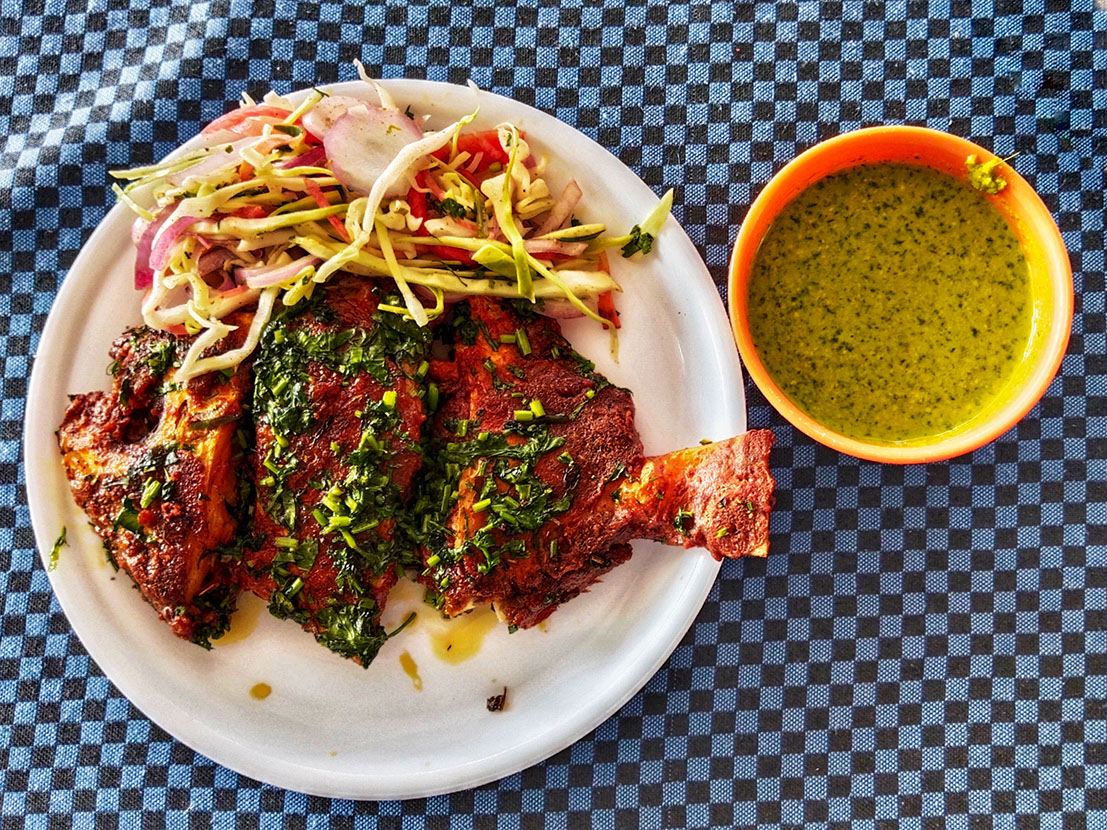
Satiate your taste buds with fresh 'bangada' fish
It's the perfect setting for a sumptuous lunch that will transport you to a state of bliss as you enjoy the gentle breeze and rhythmic sound of the waves. Let the fresh catch of the day, expertly prepared by skilled chefs, tantalize your taste buds and leave you craving for more. But fret not, for vegetarians also have a plethora of options to explore in Daman's culinary landscape.
Jampore Beach
Having had our fill of history, it was time to unwind. Nothing beats the serenity of a beach sunset. The mesmerizing hues of orange never fail to captivate, no matter how many times you've witnessed them. Even after countless sunsets and sunrises, they remain my cherished moments.
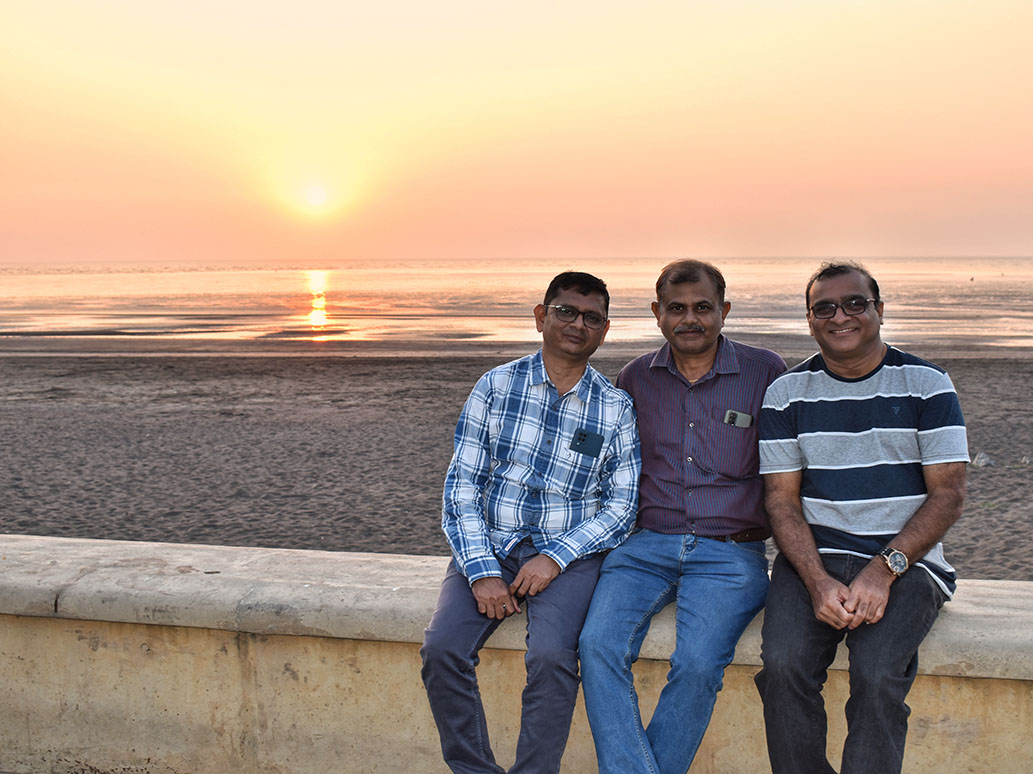
As they say, the three musketeers: bound by friendship, united in adventure
This time, we decided to forgo Devka beach, which had lost its luster and cleanliness. Instead, we embraced the beauty of Jampore beach, with its stunning shoreline road and absence of beachfront establishments. This thoughtful approach preserves the beach's cleanliness and charm. With the beach road dividing the serene forest and the ocean, Jampore beach emanates a unique and enchanting ambiance.
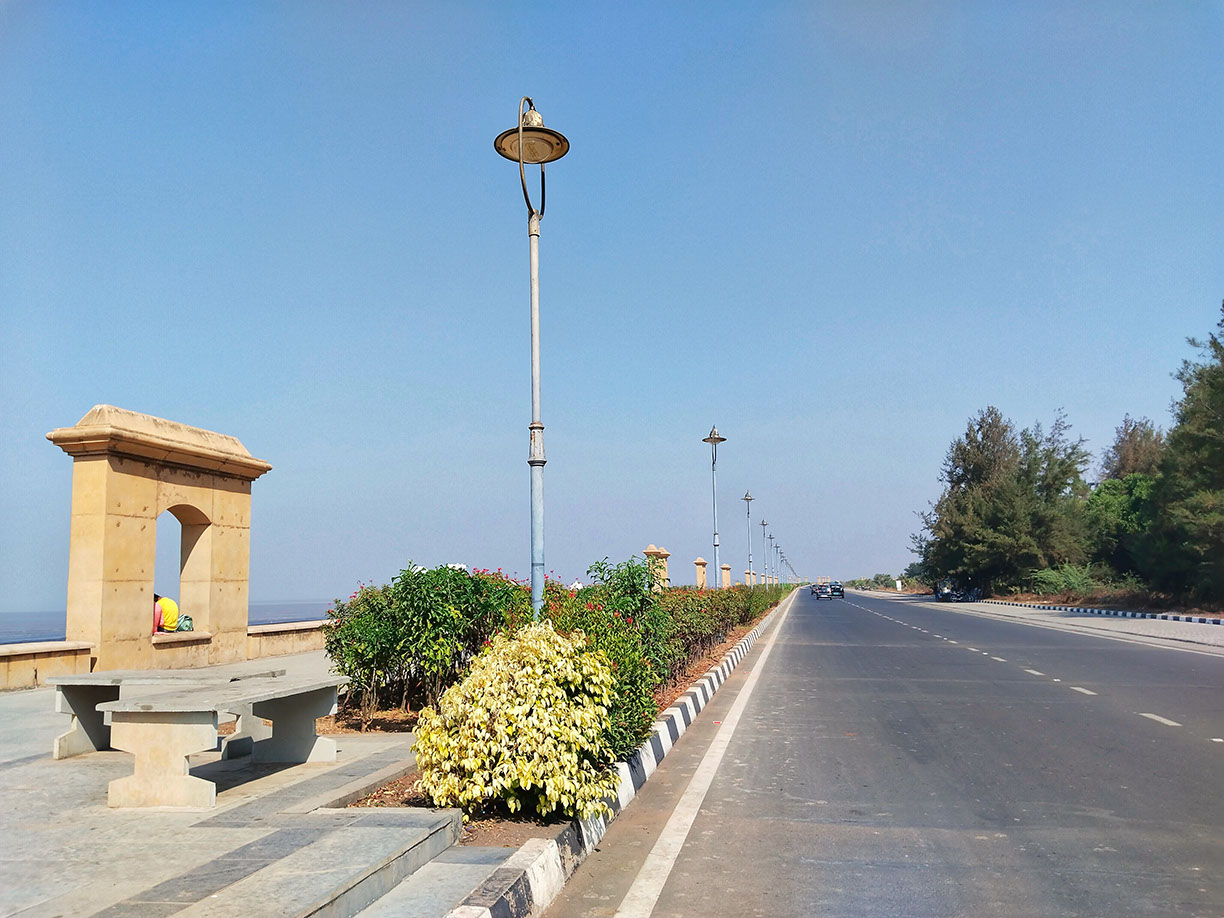
A picturesque beach road and scenic walking path lining Jampore Beach
For those in search of an adrenaline rush, Jampore beach is the perfect destination as it offers a plethora of water sports activities. With operators situated at both ends of the beach, visitors can choose from a variety of water rides, ranging from simple to exhilarating, including the enchanting banana boat ride. Similar to Bhavnagar, Daman is located along the shores of the Gulf of Khambhat, historically known as the Gulf of Cambay. This gulf is renowned for its tidal amplitude, resulting in frequent tidal variations. During low tide, the water recedes deep into the sea, revealing vast stretches of exposed sand, creating the illusion that the sea has vanished. If you plan to engage in watersports at Jampore beach, make sure you arrive during high tide.
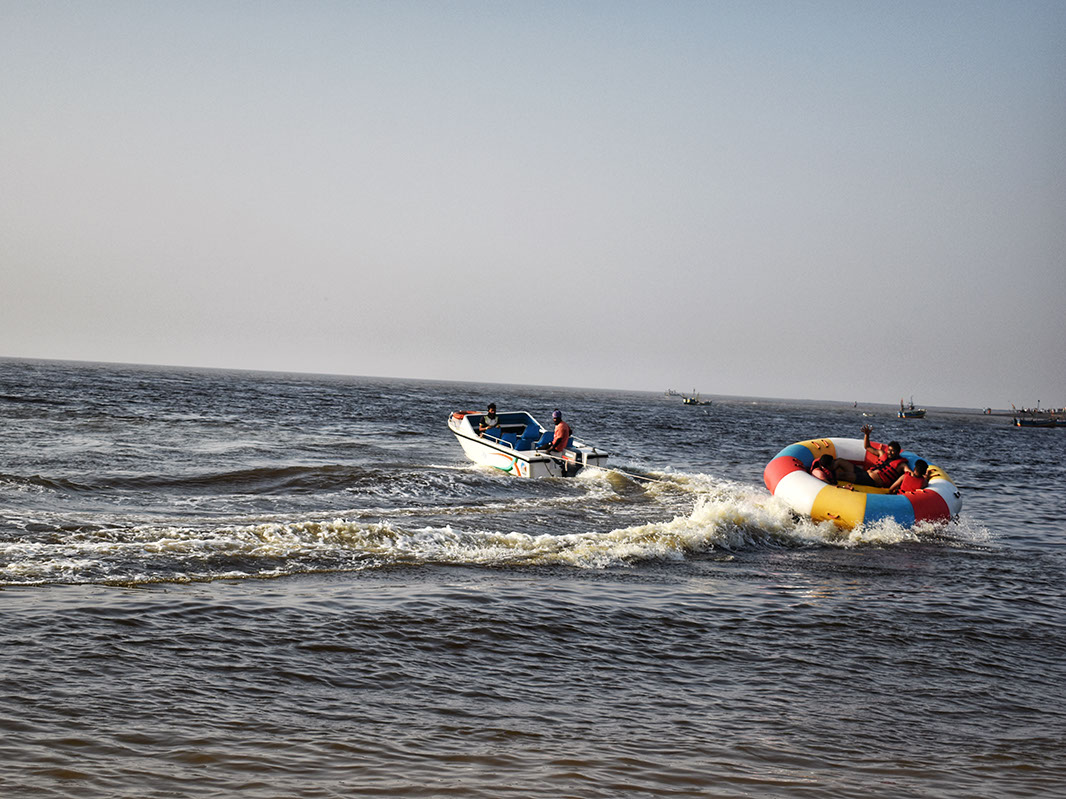
Among the things to do in Daman are watersports at Jampore beach
Jampore beach is a popular destination for morning walkers among the residents of Daman and Vapi. As Sunday approached, the beach came alive with activity. Being an early riser, I couldn't resist the chance to stroll along the shore and immerse myself in the morning vibes. With the low tide, the water had receded, revealing a vast expanse of flat seabed, creating a vibrant gathering spot for the locals.
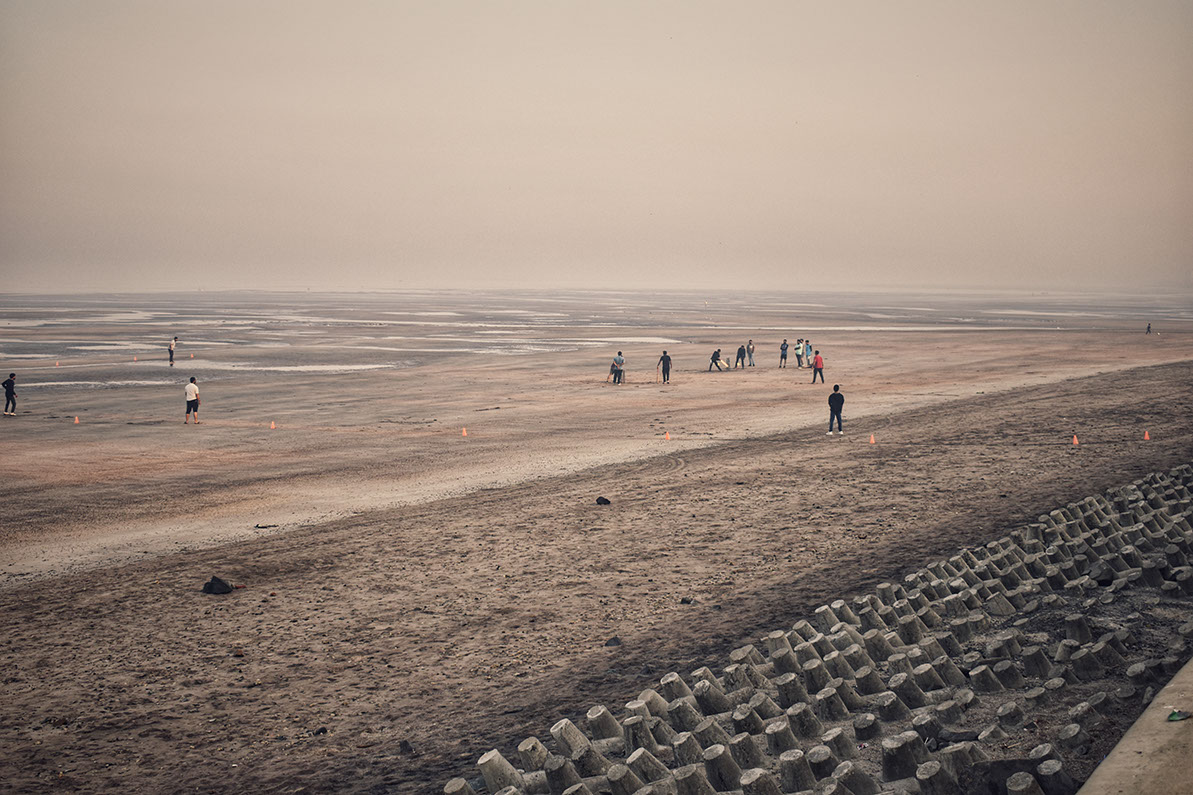
When the tide retreats, the seabed becomes a cricket field
The surge in tourism in Daman has attracted a wave of millennials, evident in the vibrant outlets near the garden at the far end of Jampore beach. With tattoo artists, hair stylists, and trendy food joints, the place buzzes with activity. Even though I visited during the off-peak season, the bustling scene indicated that they must be doing a brisk business during peak tourist months.
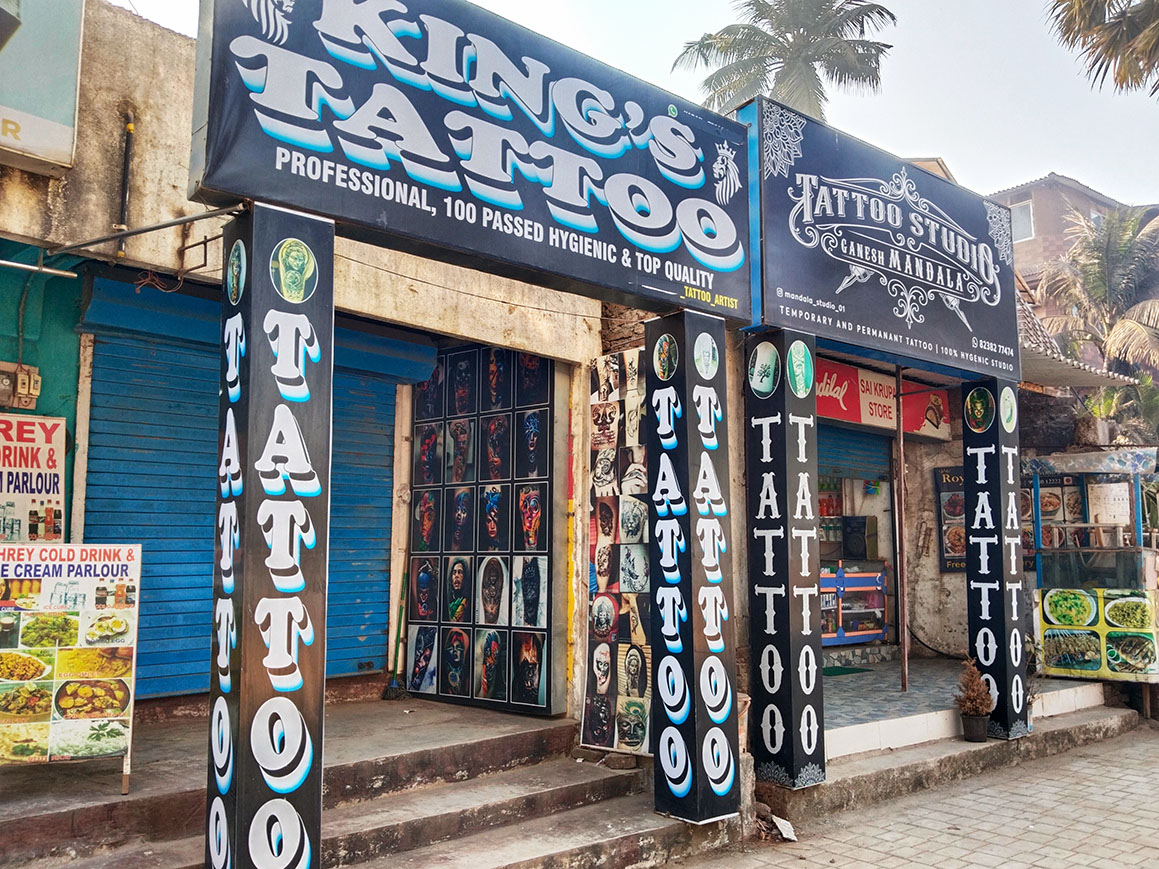
On the side of a beach garden are tattoo studios and eateries
Daman and its neighboring regions offer a haven for birdwatchers, boasting a plethora of uncommon and rare species. Across from Jampore beach lies a quaint forest area where an aviary is being established. As a bird photographer, I couldn't resist the opportunity to explore the site and was pleasantly surprised to spot several beautiful birds in their natural habitat. It turned out to be an unexpected and delightful bonus to my trip to Daman.

Some of the birds that I spotted in Daman
The Night of Enchantment in Daman
As night falls, Moti Daman unveils a mesmerizing spectacle of lights, transforming the city into a captivating visual delight. Daman, once a nerdy watering hole for Gujaratis, now boasts a sparkling nightscape adorned with enchanting illuminations. Driving along the roads of Daman, particularly those leading to the fort and its surroundings, offers a breathtaking experience for the senses. The Daman Ganga river is adorned with glowing fountains, creating a captivating display of shimmering water. The lawns surrounding the fort walls are adorned with delightful lighting, casting a magical glow that enhances the architectural beauty.
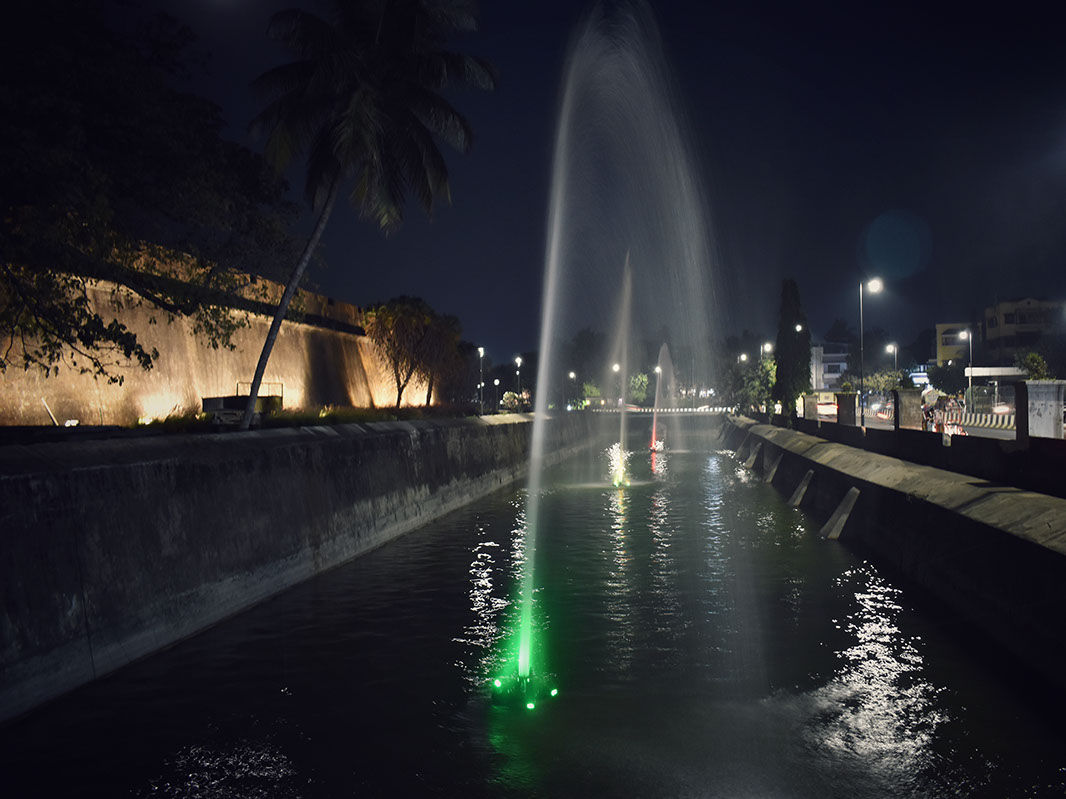
With illuminated fortress walls and glowing fountains along the Daman Ganga river
When the night falls in Daman, the culinary scene comes alive, and it's hard to resist the allure of the local food, especially in Gujarat. Even though Daman is technically not in Gujarat, the influence of Gujarati cuisine is evident, especially in the late-night food culture. As a popular destination for visitors from Surat, you cannot overlook the availability of exotic egg dishes from Surat. Just a stroll through Nani Daman, and you'll come across a multitude of roadside restaurants, tempting you with a wide array of delicious egg varieties you may have never encountered before. These eateries are a true delight for any egg lover's taste buds, and I must confess, I am no exception. Indulging in "Surti egg dishes" in Daman is an experience that will tantalize your senses and leave you craving for more.
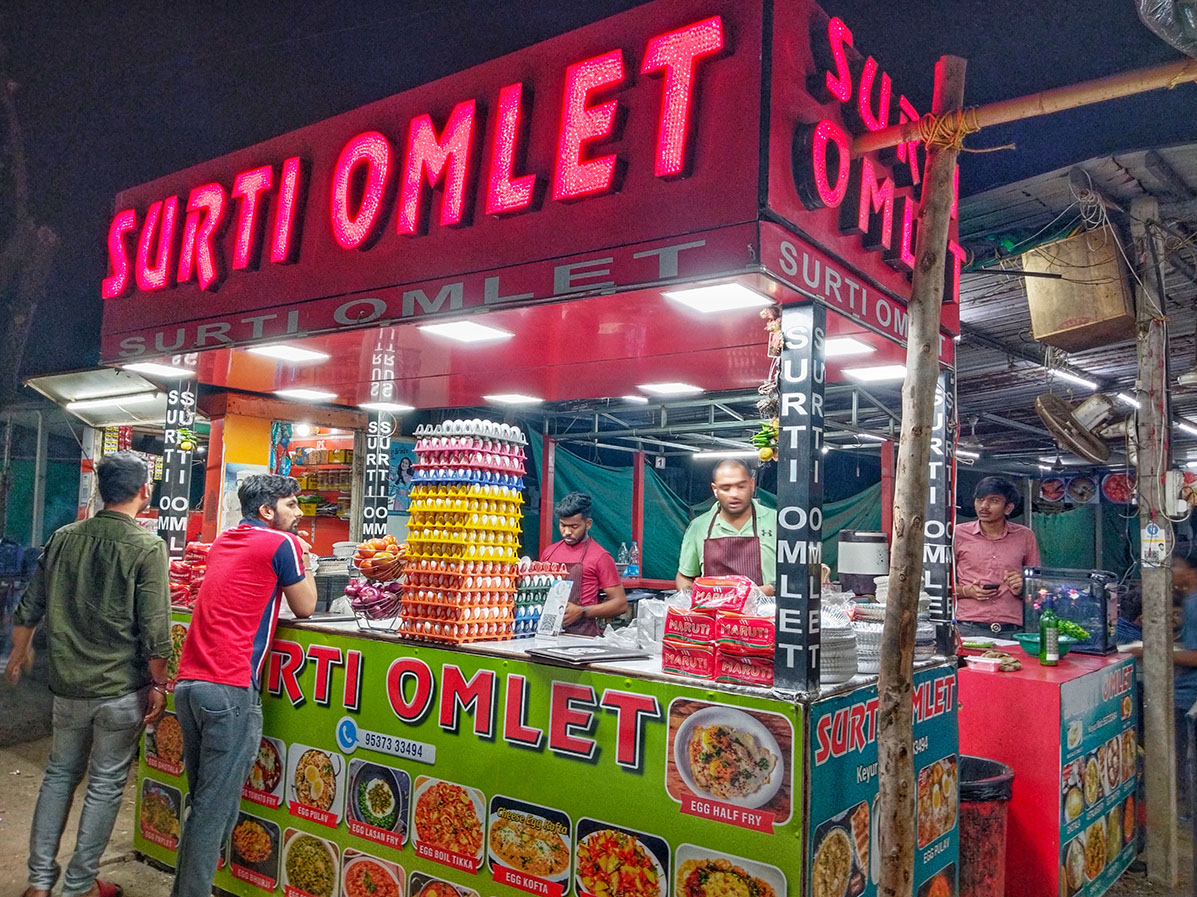
Satisfy your egg cravings without breaking the bank
Hidden Gems around Daman
Majority of tourists visiting Daman do not explore the beautiful beaches and serene nature that lie within a half-hour drive in the surroundings. Or maybe, they are not aware of them. My next day was planned to spend some time with my friend's family at their home. While returning to Atul, we stopped at one such serene place off tourist radar.
Tithal Beach
Located near Valsad, Tithal Beach is a scenic destination with a perfect mix of natural beauty and tranquility. It is a paradise for beach lovers due to its golden sands, clear water, and soothing sea breeze. Known for its cleanliness, the beach offers a tranquil setting conducive to relaxation and leisurely strolls along the shore.
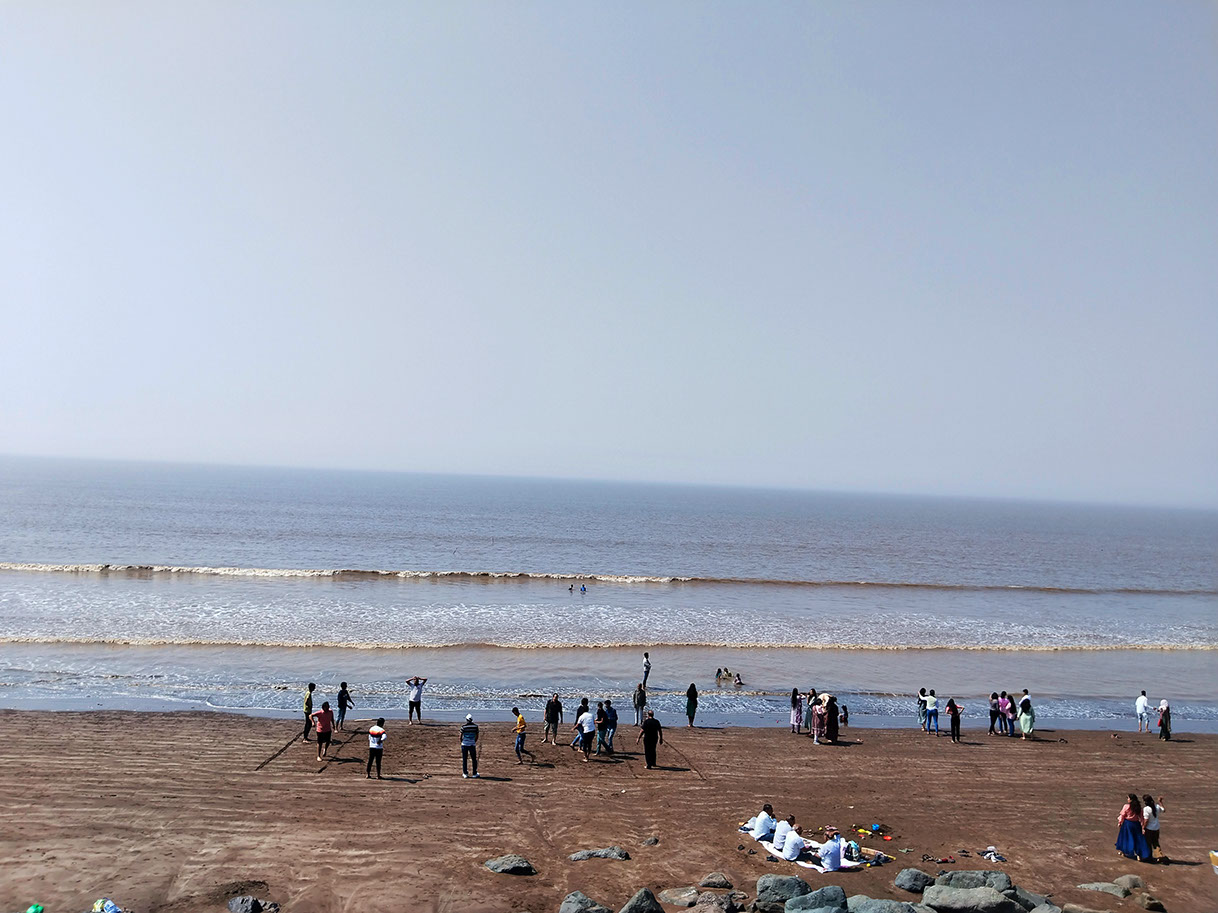
A delightful Sunday picnic at Tithal Beach
Located just a short walk away from Tithal Beach is the Swaminarayan Temple, a beautiful seashore temple dedicated to Lord Swaminarayan. It showcases magnificent architecture and exquisite craftsmanship. As a result of the temple's serene ambiance and aura, it is a popular destination for pilgrims seeking spiritual guidance.
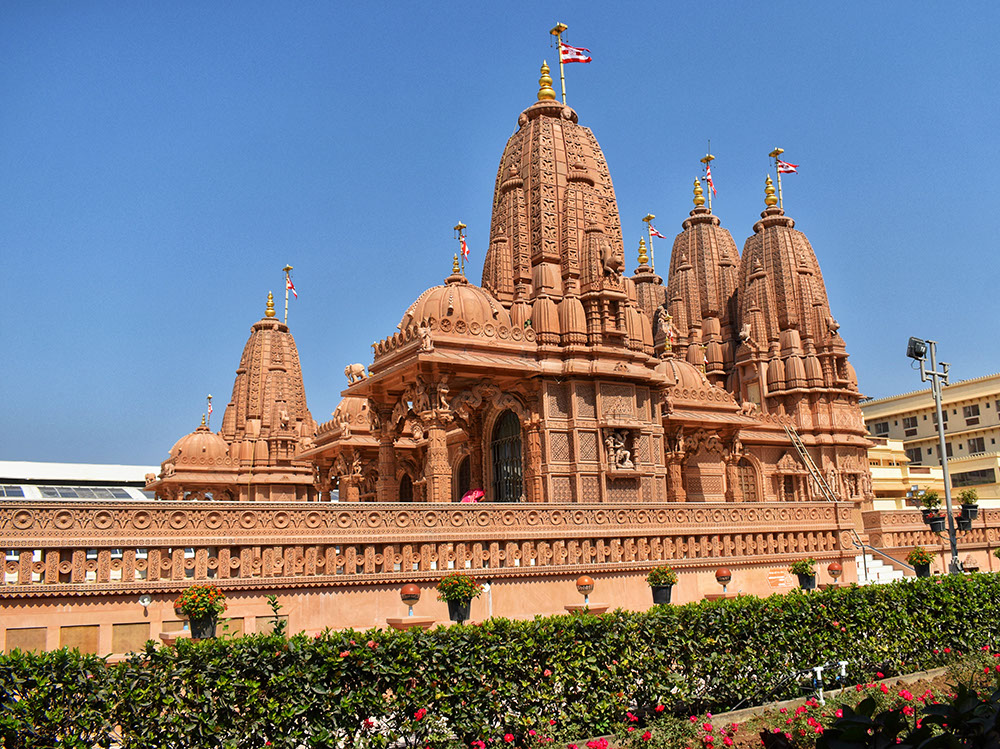
BAPS Swaminarayan Temple at Tithal beach
Parnera Hill
I spent the remainder of the day in the company of my friend and his family at their home in Atul. Knowing that I had a train to catch the following day for Vadodara, we embarked on our last adventure before my departure. Our plan was to trek to Parnera Hill in the early morning.
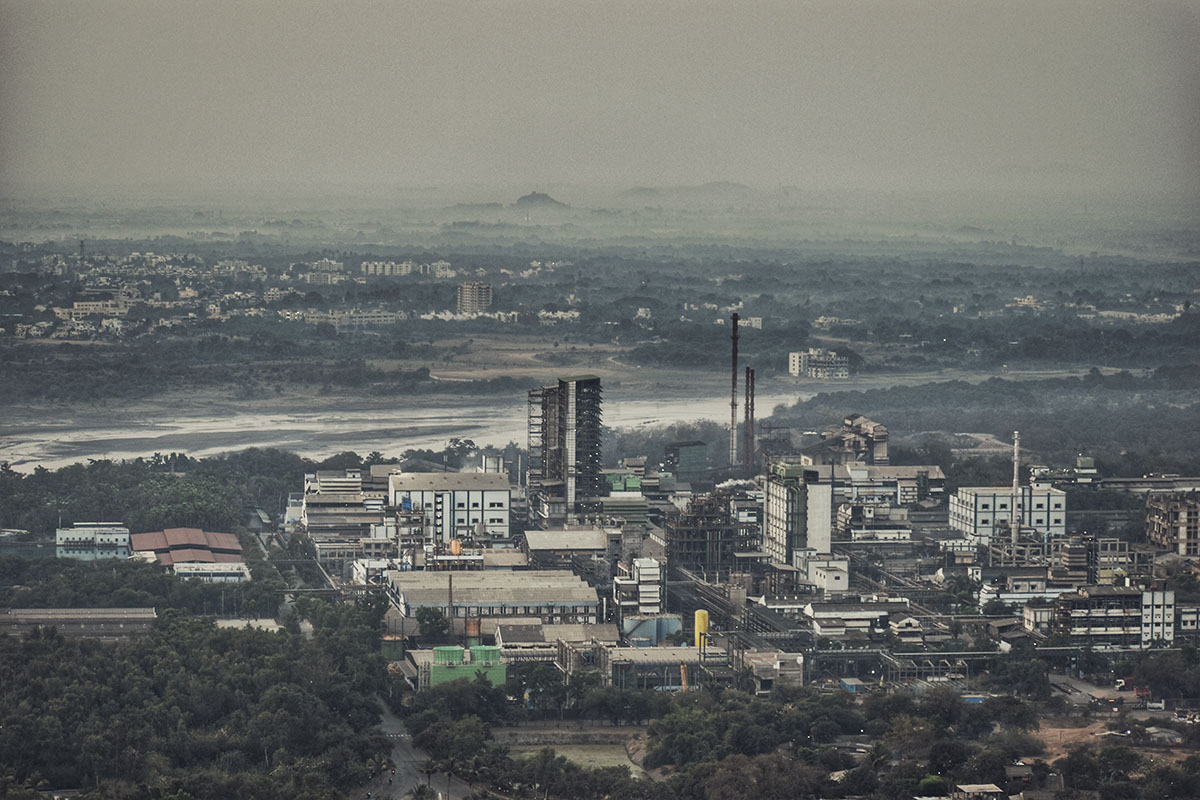
A mesmerizing view of Atul's manufacturing facility while climbing Parnera Hill in the early morning
There are two entrances to the hill. One through Parnera town near Valsad, comprising approximately 450 steps, and the other from Atul, with a challenging ascent of 999 steps. Given our proximity to Atul, we naturally opted for the latter option.
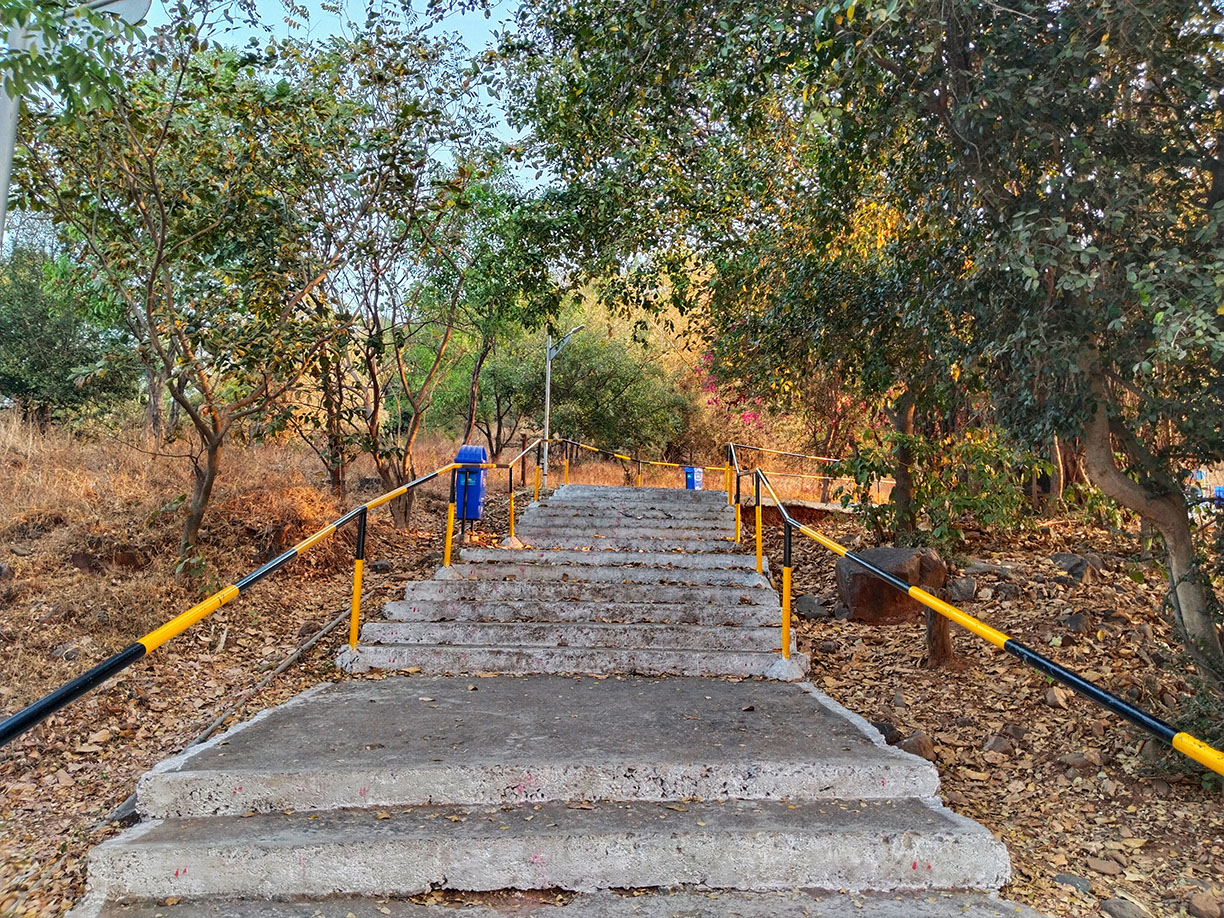
Path to Parnera Hill winds through lush forest, offering a serene and picturesque trekking experience
Parnera Hill holds an intriguing yet lesser-known history. In ancient times, a Hindu king constructed a fort atop the hill, which was later seized by Sultan Mahmud Begada from Champaner in the 15th century. During the Portuguese settlement of Daman, they captured the fort between 1558 and 1568. Subsequently, in 1696, the army of Shivaji Maharaj established a military base on the hill. The Gaikwads of Vadodara later gained control of Parnera Hill until it fell under British occupation in 1780. Sadly, the fort was completely razed during the Indian Mutiny of 1857, but remnants of its existence can still be found, serving as silent storytellers of the past.
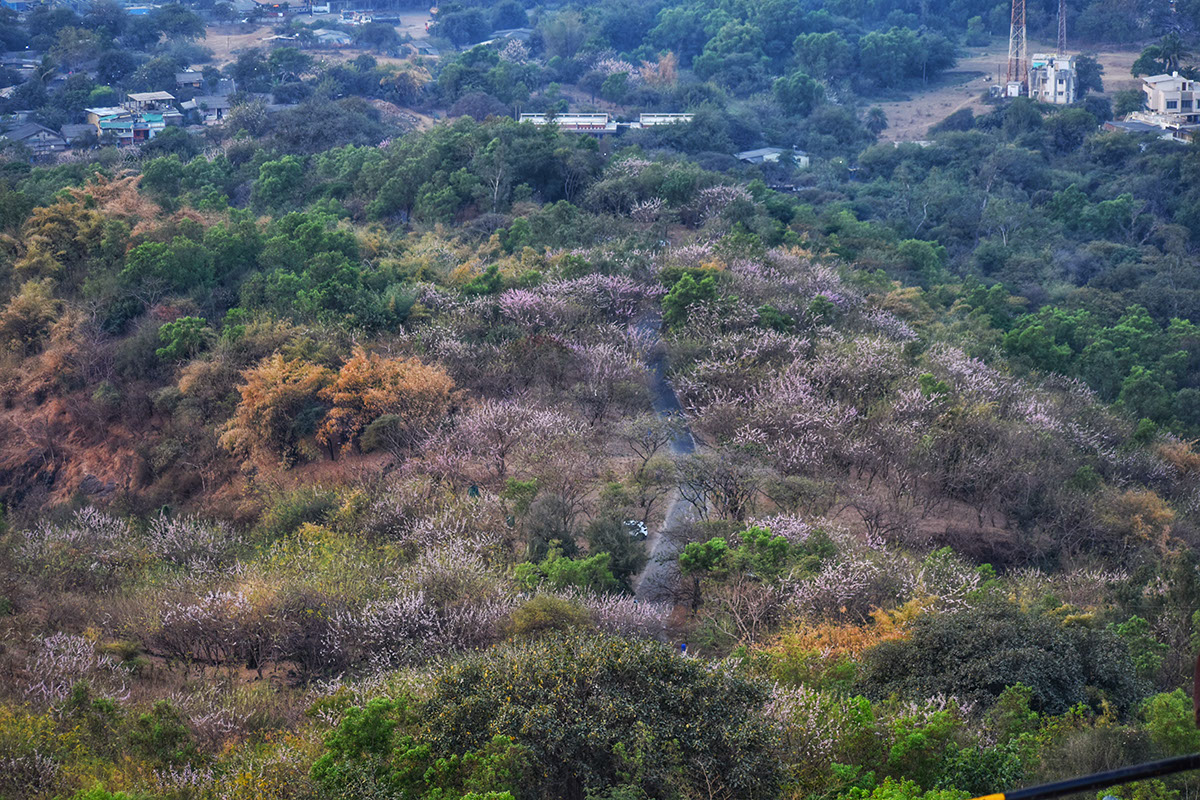
Spectacular landscape from the Parnera Hill
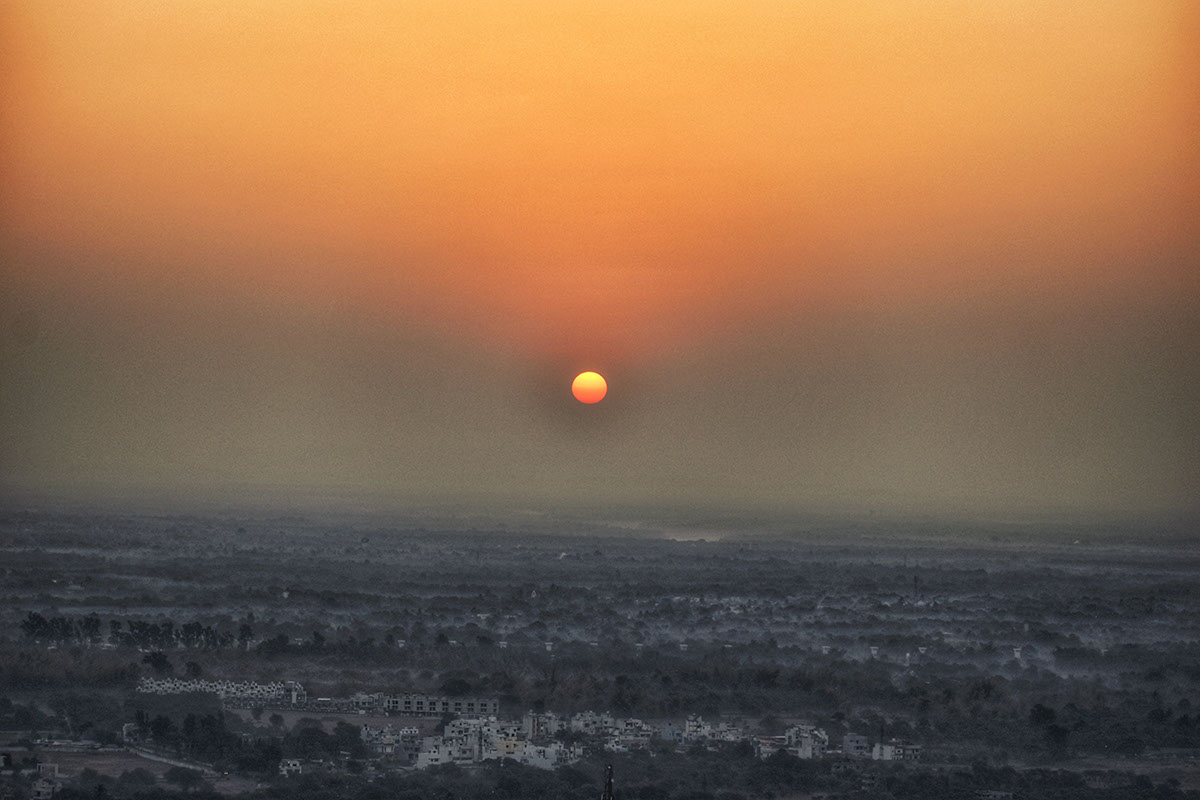
Captivating sunrise casting its golden hues from the pinnacle of Parnera Hill
Atop Parnera Hill, you will find three magnificent temples that attract devotees from far and wide. These temples are the Mahakali temple, which holds great reverence, the temple housing the divine presence of Shree Chandika, Shree Ambika, Shree Navdurga, and Shree Sheetla Mata, and a serene Hanuman temple.
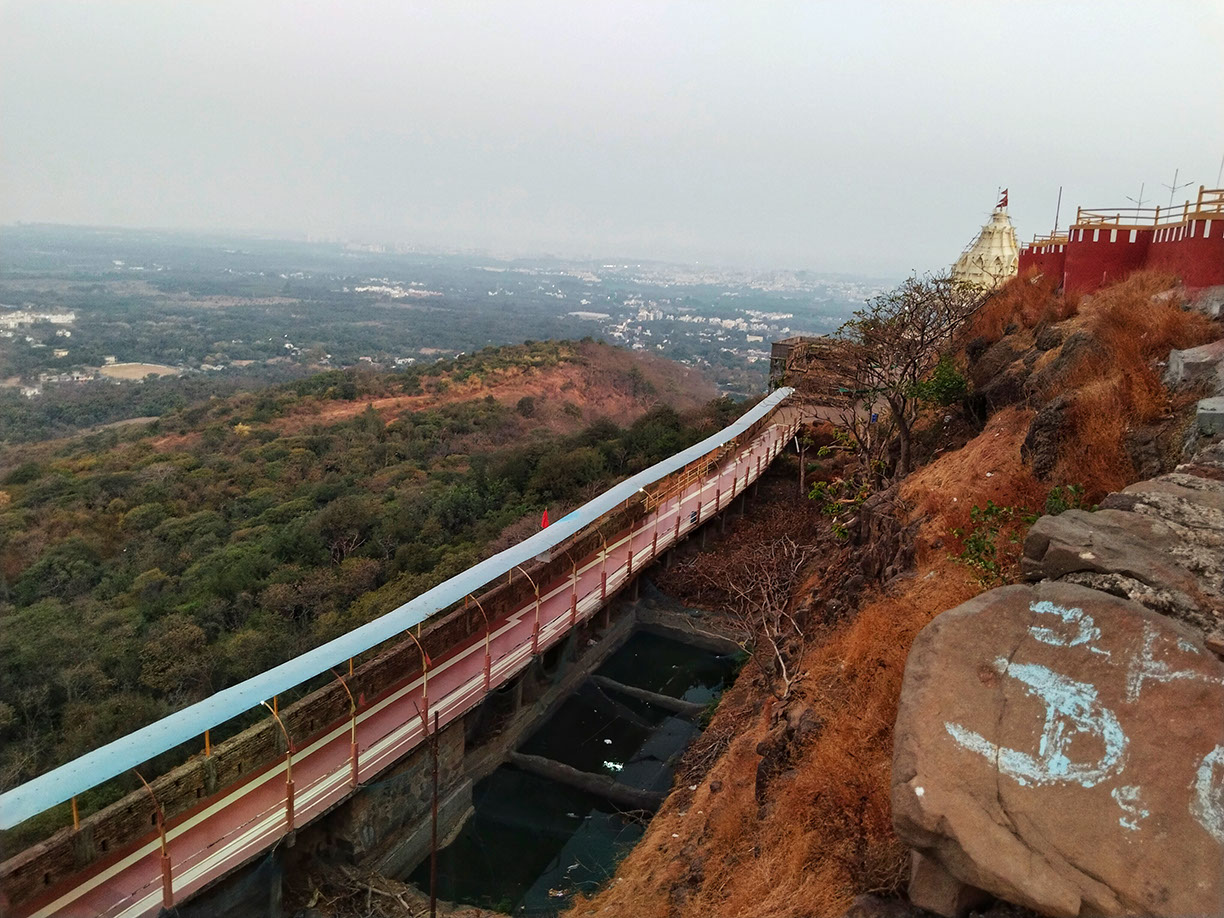
The enchanting path to the temples winds through the remnants of the ancient fort
A Nostalgic Journey to Daman
It was time to say our goodbyes, cherishing the memories of our unforgettable trip to Daman and the precious moments of our reunion after more than a decade. Prakash and Bharat graciously offered me a ride to Vapi Railway Station, where I boarded a train to Vadodara, my next destination. Vapi's newly renovated railway station seamlessly blends old British charm with modern conveniences. If you find yourself there, be sure not to miss the opportunity for a memorable selfie at the selfie point. As I boarded the train, I brought with me warmth of friendship and indelible experiences that I will cherish for a long time.
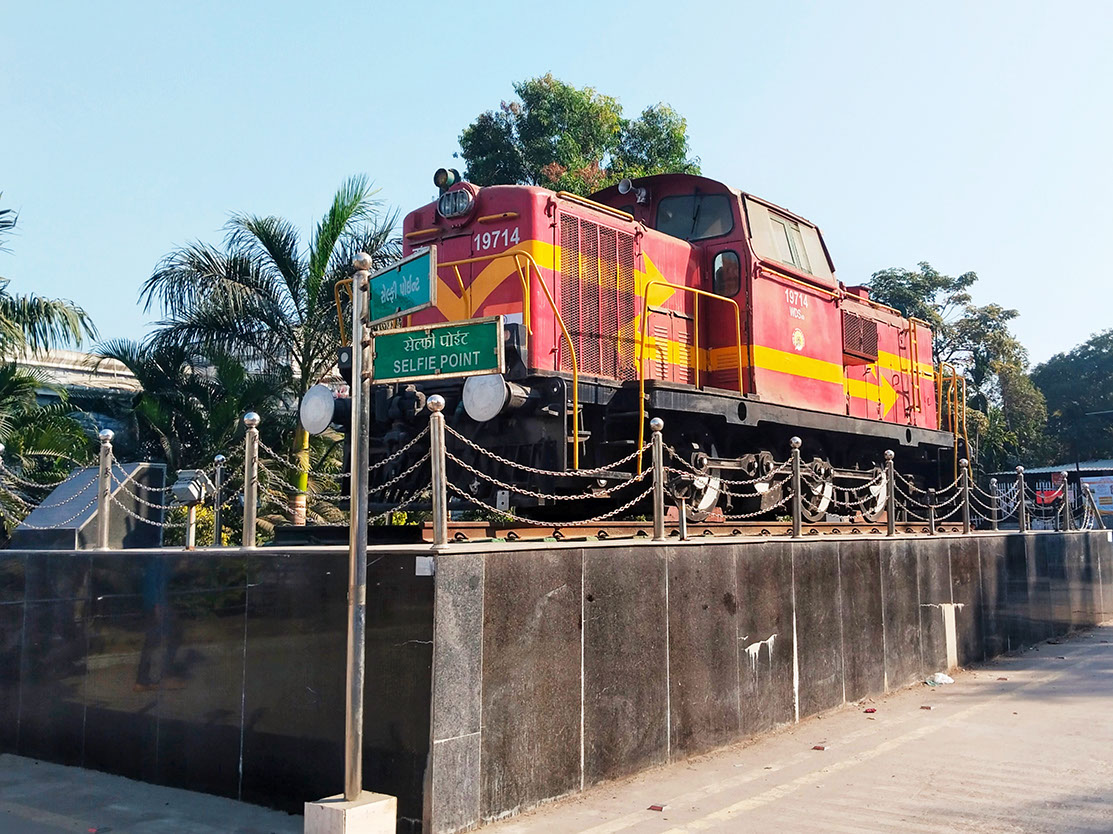
The selfie point at Vapi Railway Station features an old diesel locomotive monument
Frequently Asked Questions:
What are the best ways to reach Daman?
There are several ways to reach Daman:
- By Air: Mumbai International Airport is the nearest airport to Daman. You can take a taxi, train, or bus to Daman from there, which takes approximately 3-4 hours.
- By Train: Nearest railhead to Daman is Vapi Railway Station, about 12 kilometers away. Vapi is well connected to major cities in India, and you can get to Daman by taxi or bus from there.
- By Road: Daman is easily accessible by road since it is well connected to several cities in Gujarat and Maharashtra. The National Highway 48 connects Daman with Mumbai and other major cities.
- By Bus: Mumbai, Surat, Ahmedabad, and Vadodara have regular bus services to Vapi and Daman. Buses operating on these routes are both state transport and private, providing convenient options for travelers.
What transportation options are available in Daman to get around?
Although Daman has a public bus system, it is not practical for tourists. Having your own vehicle or renting a full-day auto rickshaw (3-wheeler auto) is the best way to explore Daman. Daman still lacks the convenience of hiring a scooter or car, unlike Goa.
When planning a trip to Daman, are there any annual events or festivals worth considering?
When planning a trip to Daman, there are two annual events worth considering:
- Nariyal Purnima: Nariyal Purnima marks the beginning of the fishing season and is celebrated during the full moon day of the Hindu calendar month of Shravan (August). For the fishing community in Daman, it is a significant event. The fishermen decorate their boats and offer coconuts to the sea in order to seek blessings for a prosperous fishing season. It is a joyful atmosphere filled with folk performances and music.
- Navaratri (Garba): Navaratri, meaning "nine nights," is a major Hindu festival celebrated with great fervor in Daman. It consists of nine nights of vibrant music, dance, and devotion to Goddess Durga. People dress in colorful traditional clothing and form synchronized circles to dance to rhythmic music. Throughout the night, the celebration continues to create an electric atmosphere of joy and celebration.
Since this festival is celebrated according to the Hindu calendar, its dates vary. Check the exact dates of these events and plan your trip accordingly.
What is the weather like in Daman throughout the year?
Daman experiences a tropical climate throughout the year. From March to June, the summers are hot and humid with temperatures ranging from 25 to 40 degrees Celsius. Heavy rainfall and thunderstorms are common during the monsoon season, from June to September. Winters in Daman are mild and pleasant with temperatures averaging between 10 and 20 degrees Celsius, making it an ideal time to visit.
When is the peak tourist season in Daman?
Daman's peak tourist season is in the winter months, from November to January. There are a large number of tourists during this time due to the pleasant weather and mild temperatures. Daman also experiences a peak tourist influx during Diwali in October-November, Christmas, and New Year.
How many days are enough for Daman?
It is recommended that you spend at least two full days exploring the main attractions of Daman. During this period, visitors can enjoy beautiful beaches and historical sites, as well as explore local cuisine and culture. You may want to extend your stay by a day if you wish to take part in water sports or discover nearby attractions.
Disclaimer: This blog may contain affiliate links. At no extra cost to you, we may get a small commission if you buy anything. All products and services we endorse have been personally used or come highly recommended to us. These incomes allow us to keep the community supported and ad-free.


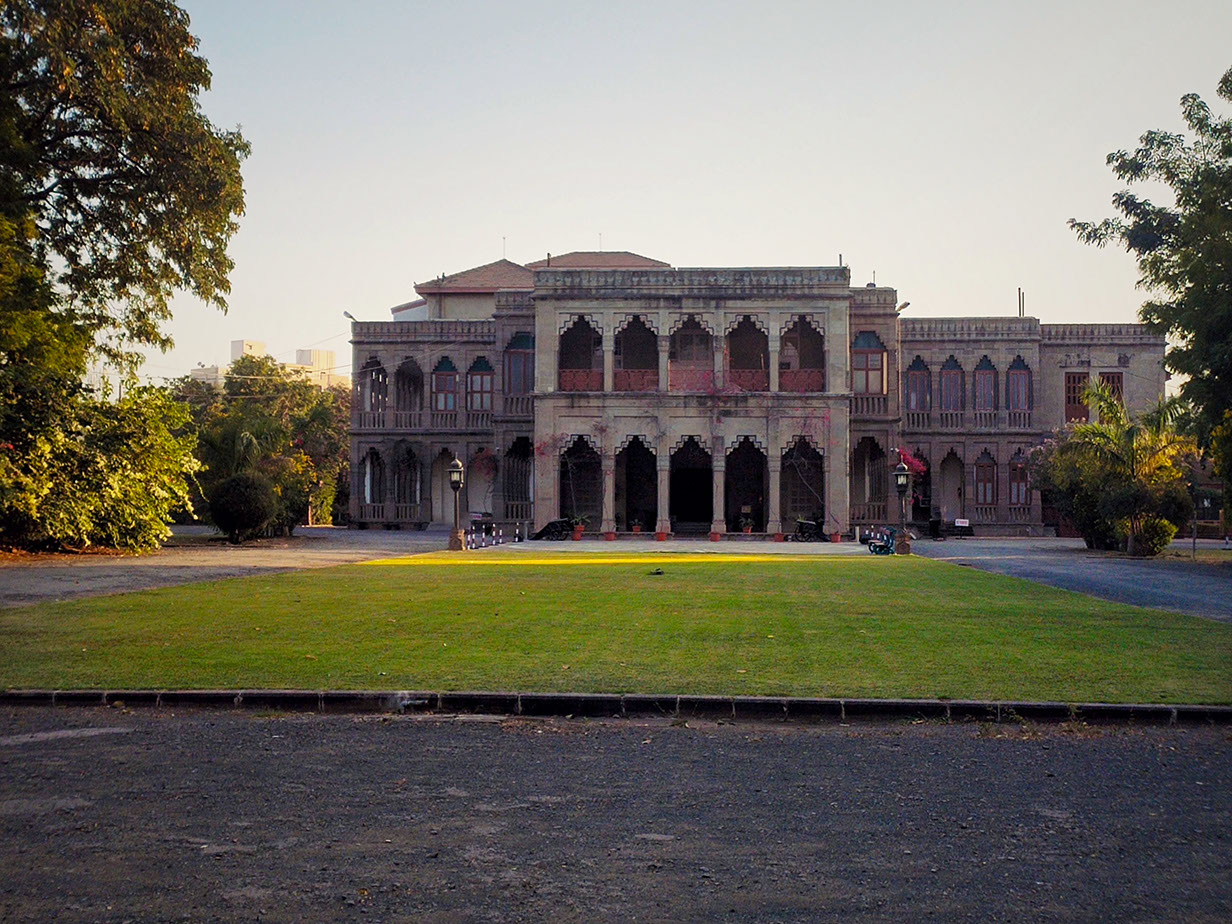
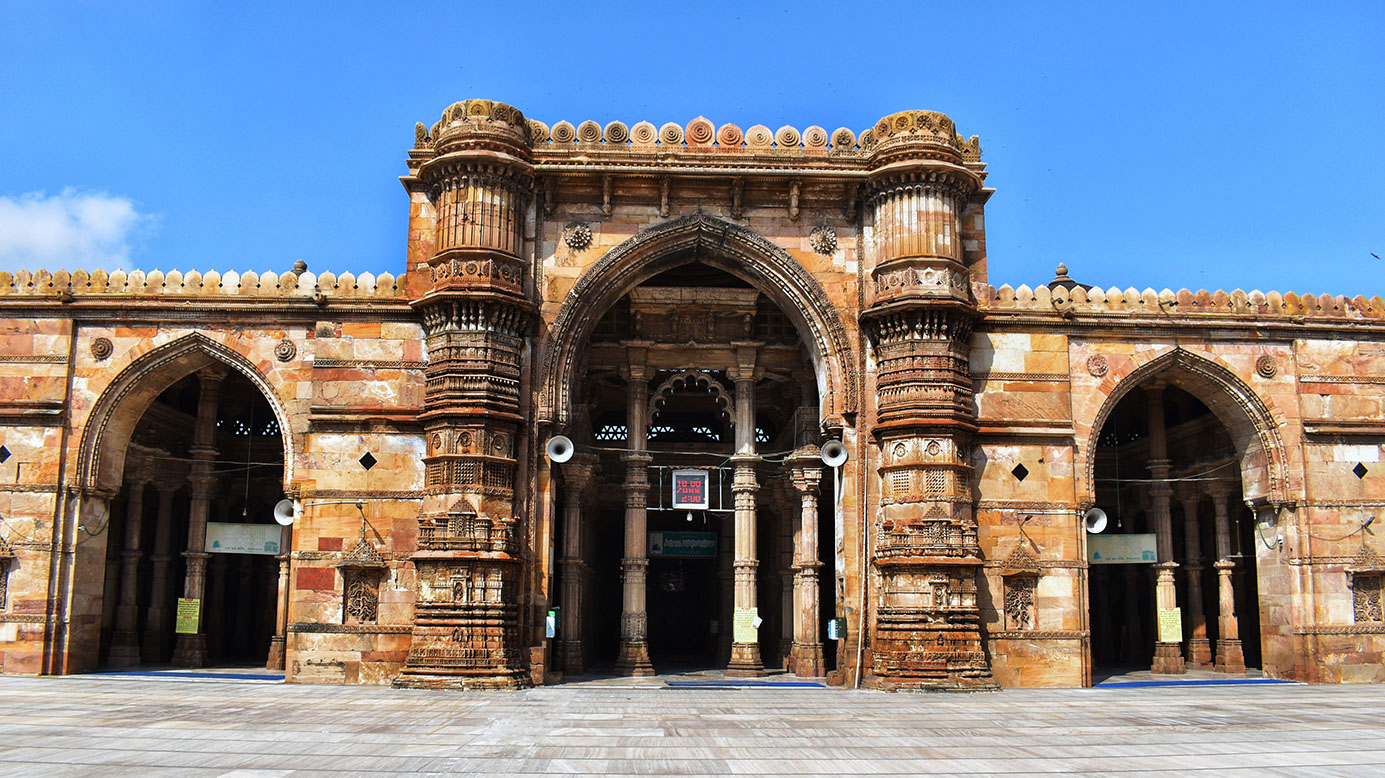
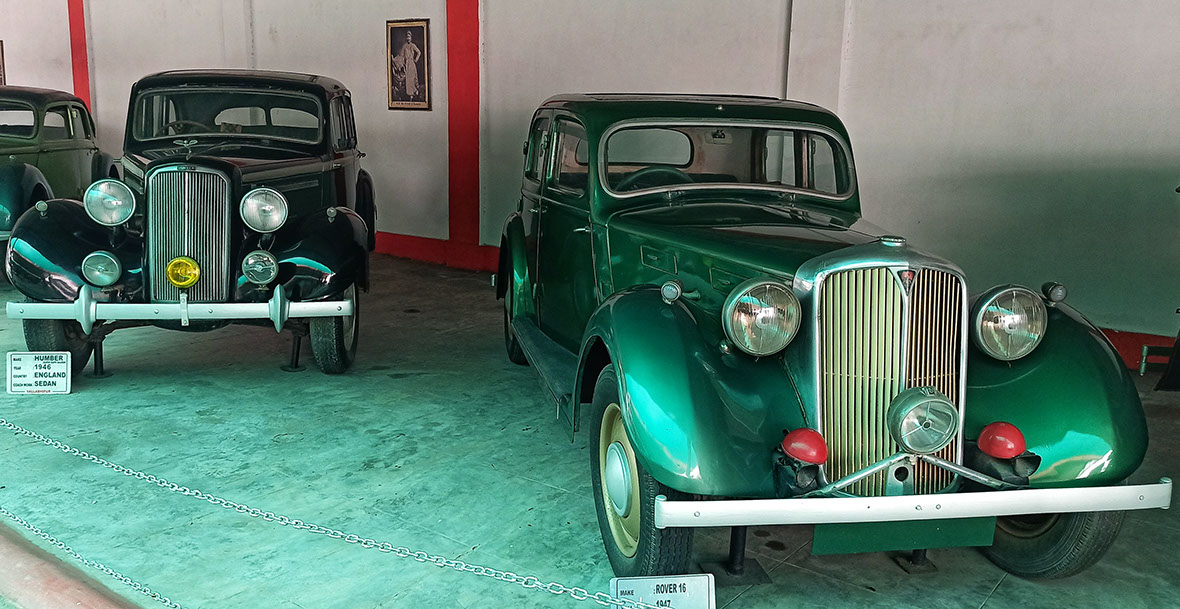

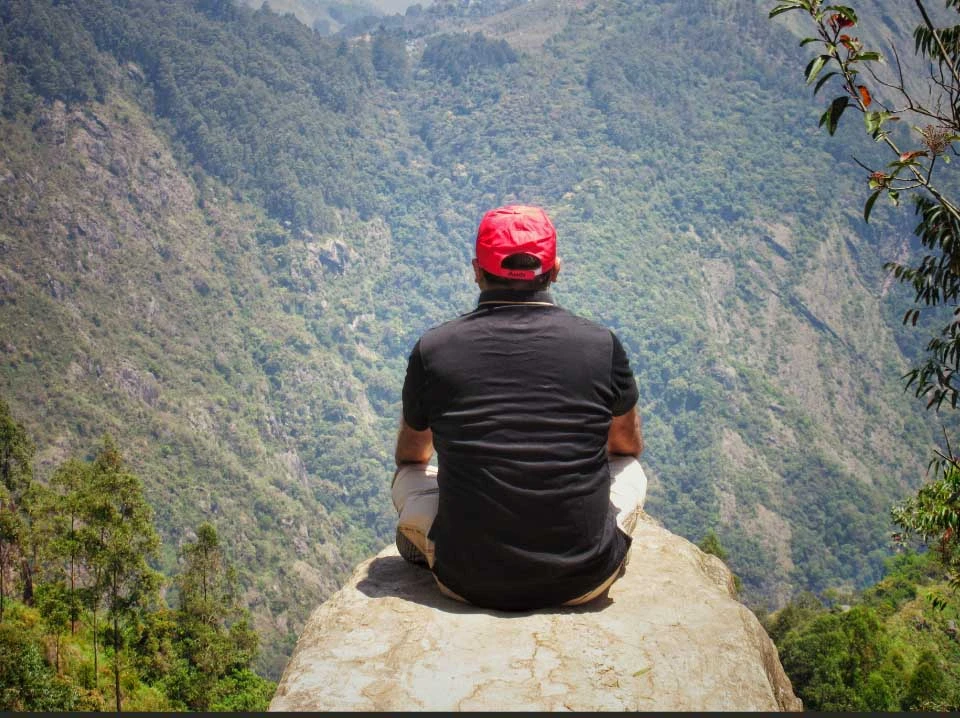
Name
Email
Comment